How to Develop a Successful PR Strategy In 2021 (Guide)
The way to develop and launch a successful PR strategy has changed. In this guide, you’re going to learn how strategic PR can help your business grow in 2021. More specifically, Read More...
There are many restrictions when it comes to CBD marketing.
The question is:
How can you market your CBD business while being legal?
Here’s what we’re covering in this guide:
Let’s get into it.
Cannabidiol – or CBD, as it’s usually called – scores highly because of its therapeutic grade and the health benefits it carries.
It was only a few months ago that Forbes published a study that claimed it’s possible to fight some COVID-19 symptoms with CBD.


That’s only one of the huge number of examples one could list in relation to CBD oil, which is derived from hemp plant leaves, stems, and flower buds.
The growth of the industry, which is firmly linked to the acceptance of cannabis and hemp derivatives globally, is rising significantly, as GlobeNewswire reports:


Despite the growth of the market and the rising numbers of CBD consumers, the CBD industry and CBD marketers are highly restricted when it comes to developing their marketing efforts and increasing brand awareness online.
In other words, although there’s awareness of the benefits of hemp derivatives for human health and wellness, which has led to growth of the CBD industry, there’s confusion around CBD marketing, especially when it comes to online platform guidelines.
In this section, we’ll be looking at the main restrictions that affect CBD business owners in terms of their marketing plan and advertising their products online, as well as on some of the most popular social media platforms.
We’ve dived deep into the restrictions of promoting your CBD products on social media.
Let’s break down our findings.
Facebook is one of the most popular and effective platforms for advertising and connecting with new audiences.
It’s constantly evolving and changing its algorithm so users – mostly business owners – have to use paid ads to promote their new products and services.
However, when it comes to CBD brands and any kind of products that include cannabinoids – the chemicals found in cannabis – Facebook might be tricky to use for advertising.
Taking a close look at their official advertising policies, we found two sections that might restrict – and from our experience they do – ads that include the term CBD and/or other relevant terms.
Have a look yourself:
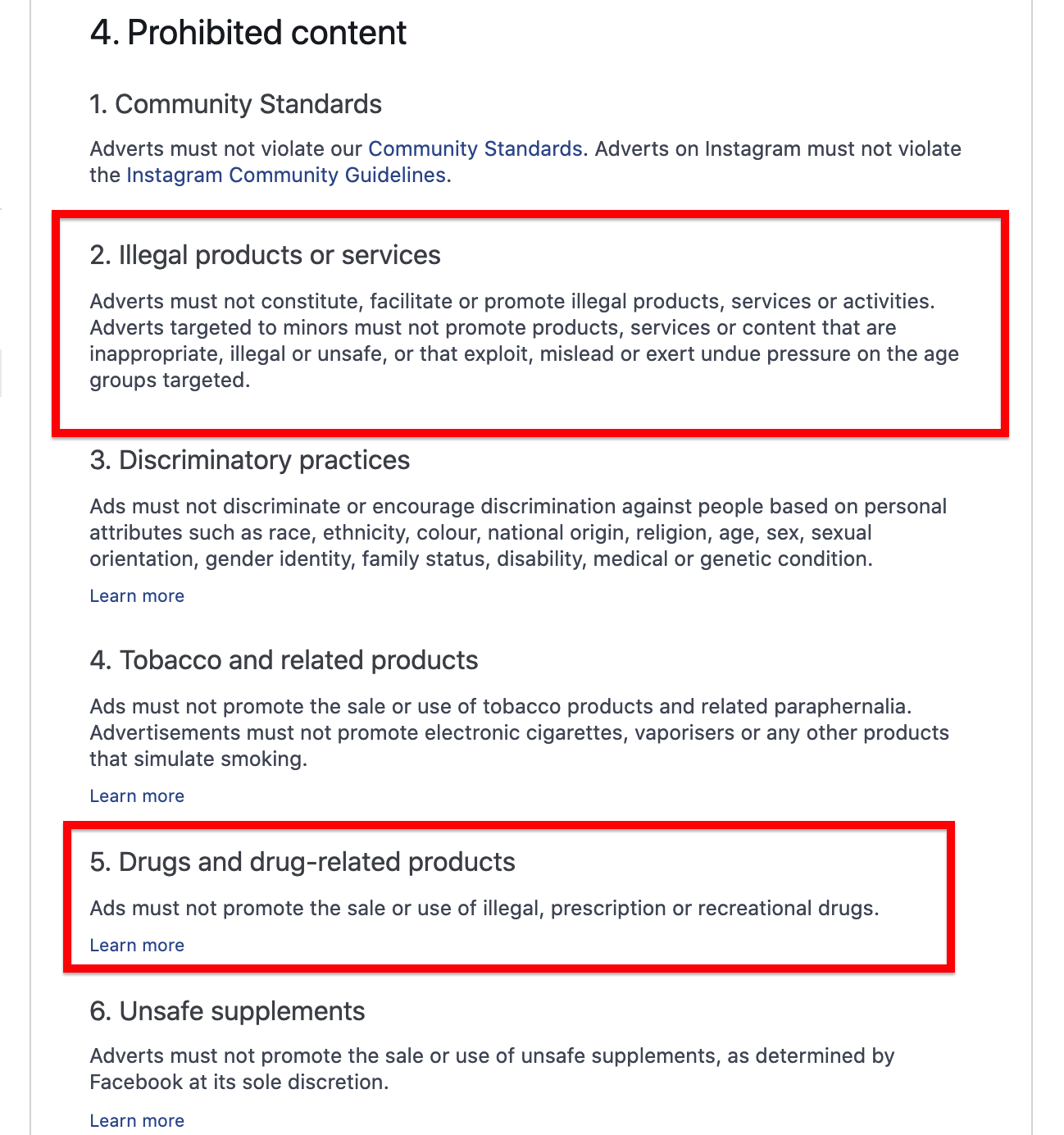

If you’ve tried to find the term CBD somewhere in that advertising policy screenshot, try no more, because it’s not there.
However, in the Facebook Ads Library we were able to locate some inactive ads that include the term CBD.
Here’s an example:
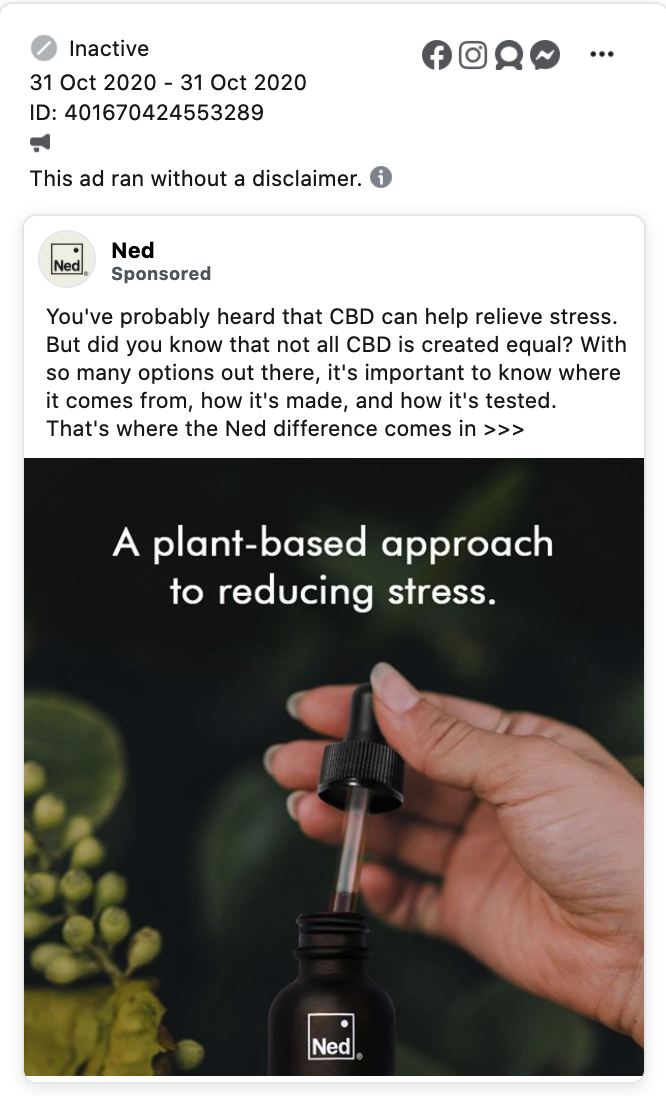

To put it simply, it’s not clear if advertisers can advertise their CBD products or not.
The small number of hemp related Facebook ads shows that you probably can advertise your product, but the restrictions make it simply just too complex.
Having said that, we wouldn’t recommend Facebook Ads as a secure and effective channel for CBD products.
According to Instagram internal data for 2018 there were over one billion active Instagram accounts and over 25 million active business accounts.
Have a look at some more data on business profiles:


We understand that business profiles on Instagram have great chances to be seen and reach their target audiences, given the popularity of the platform.
However, when it comes to CBD ads on Instagram, there’s very little information out there – which comes as no surprise given that Instagram is owned by Facebook and we’ve already seen Facebook’s advertising policies.
The Instagram advertising page promotes the types of ads one can pay for when using the platform, but there are no specific guidelines in relation to prohibited content and products that cannot be advertised.
The chances are that, if you go for a paid Instagram ad to promote, let’s say your CBD oil products, you will most probably get banned from the platform.
On the other hand, we found a recent Instagram ad that shows the opposite.
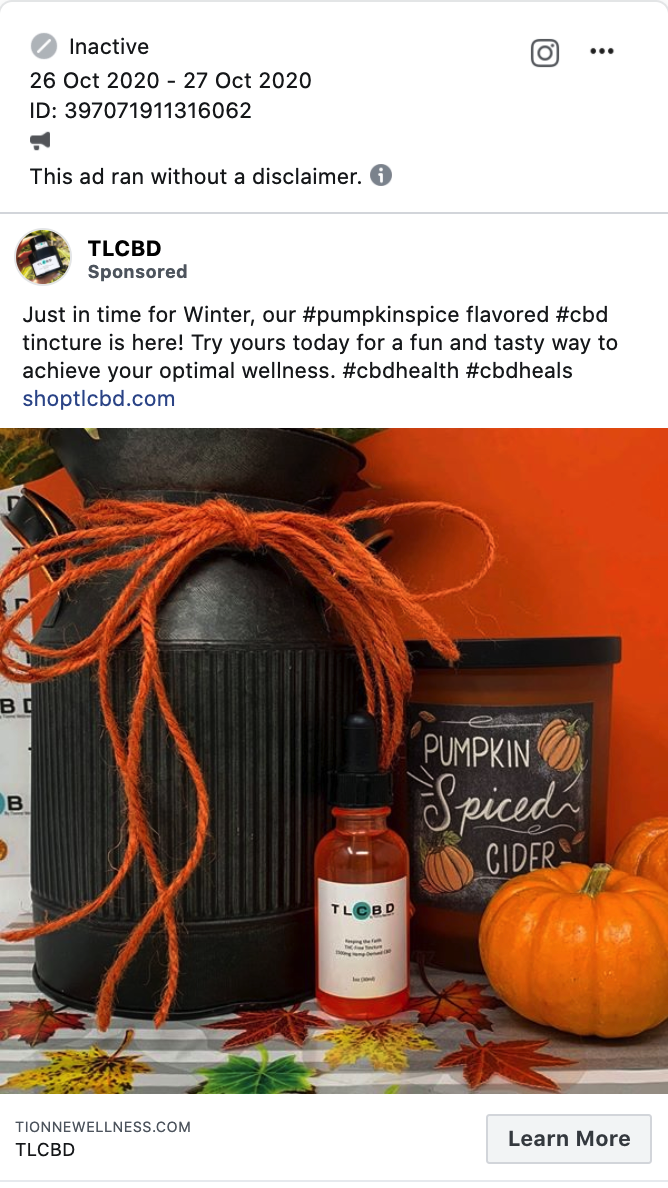

Takeaway Point: Facebook and Instagram make it too hard for CBD brands to know what their specific advertising guidelines are, thus making it less likely for them to invest in social media ads.
Interestingly enough, in the case of Twitter, we found a bit more information on advertising CBD products.
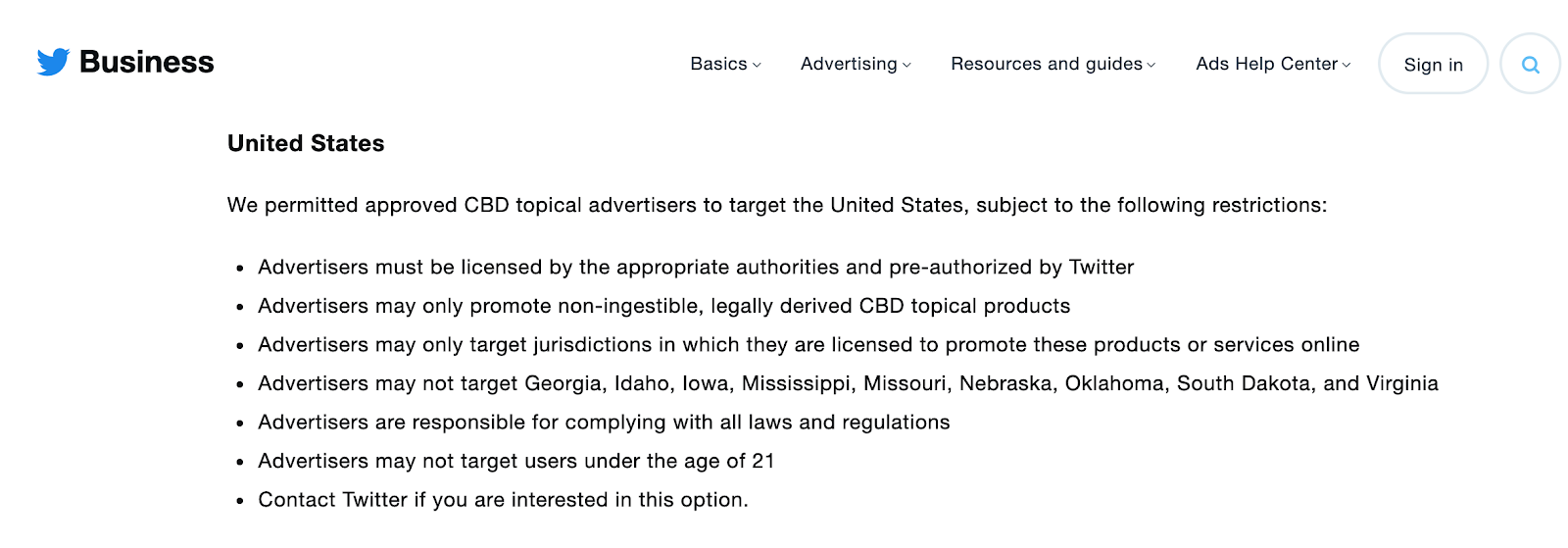

As you can see, although the platform claims to permit CBD topical advertisers to target the US, there’s a number of restrictions, including getting your ad pre-authorized by Twitter and contacting Twitter if you’re interested in advertising your CBD products.
We don’t have a clear idea of whether the restrictions are strictly applied and what Twitter’s authorization criteria are.
So, we could say that Twitter — like with Facebook and Instagram, which both have the same advertising platform — wouldn’t be a good option for you to advertise your CBD product.
Unlike other online platforms that don’t specifically mention CBD in their lists of prohibited products, Google includes cannabidiol (CBD) in its list of unapproved pharmaceuticals and supplements.
Have a look at the list below:
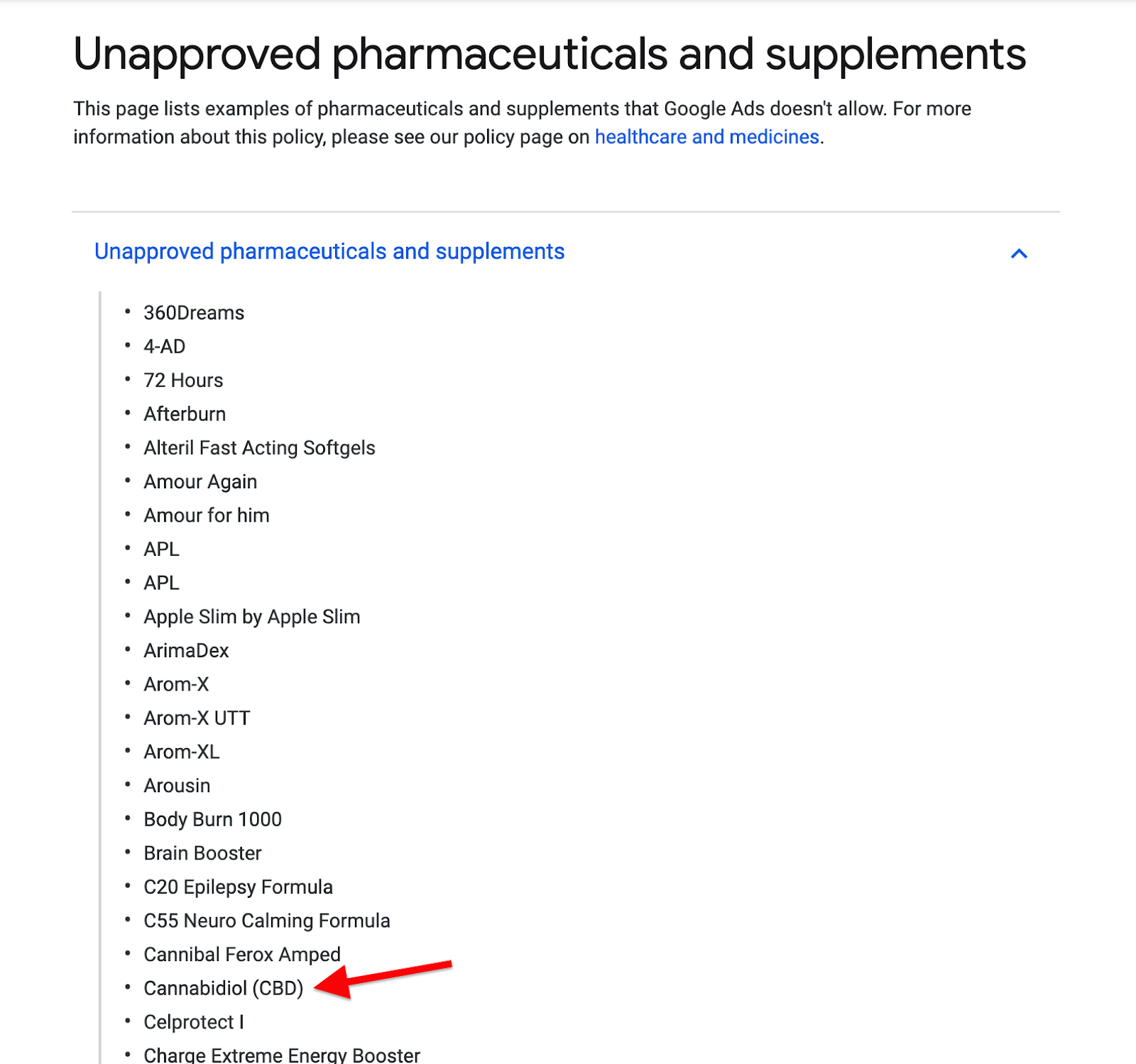

That makes it clear to us; although the United States government ban on hemp was lifted with the 2018 Farm bill, there is still confusion about the effects of CBD.
It looks like Google considers CBD to have the same psychoactive effects as tetrahydrocannabinol, also called THC – which gets people high – thus affecting the legality of advertising industrial CBD products on Google Ads.
We also did some research on e-commerce giant Amazon in an attempt to give you a definite answer on whether or not you can sell and advertise your CBD products there.
Unfortunately, similar to the platforms discussed a little further up, the confusion continues and Amazon is basically yet another online platform that makes promoting and selling CBD products uncertain and hard.
Let’s have a closer look at the Amazon Seller Policies.
A mention of CBD is found on the page shown below:
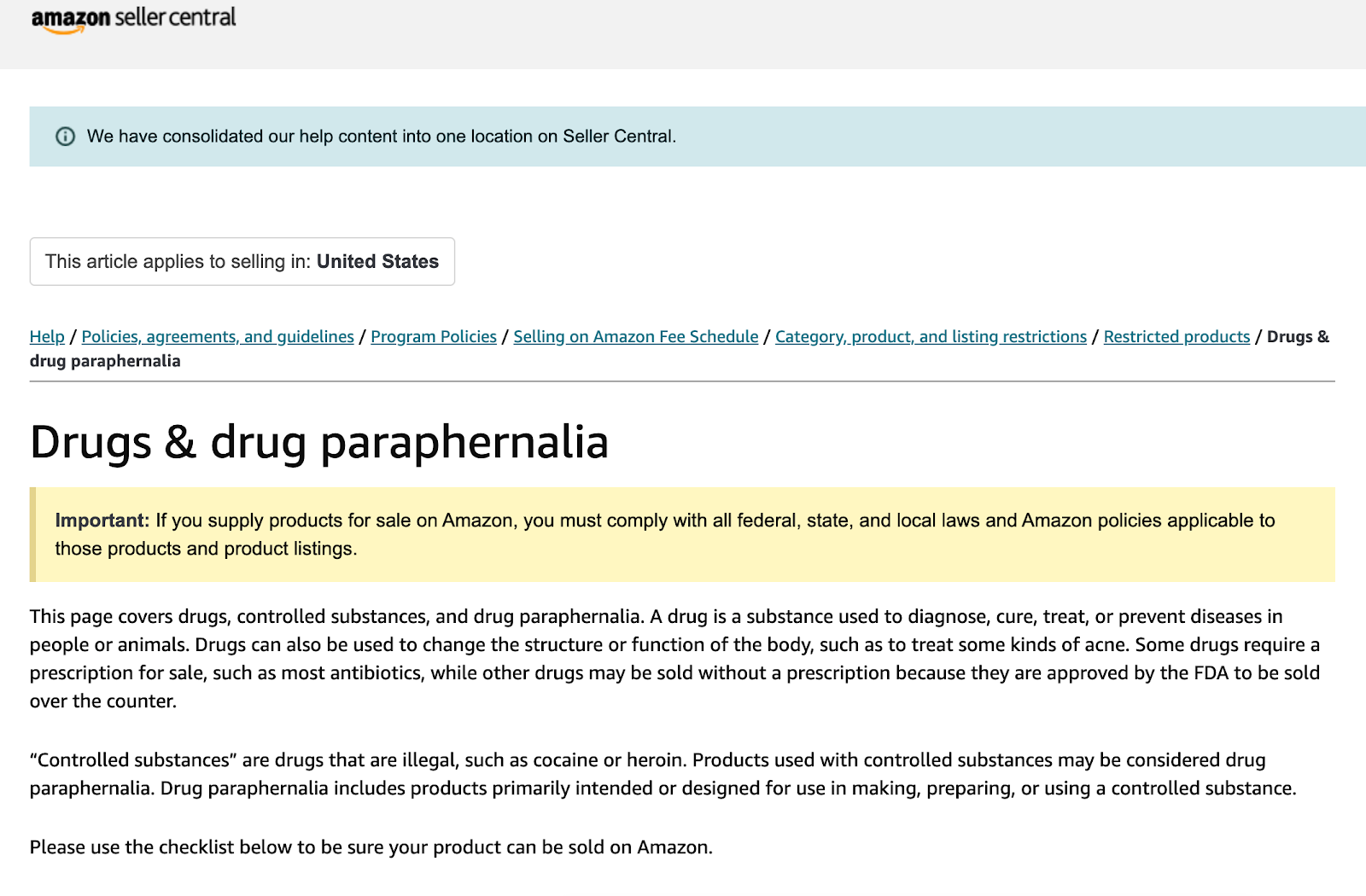

More specifically,


As you can see, the list is extremely detailed.
A specific mention of CBD products shows that using the platform to sell CBD products will be tricky, and most likely impossible to do.
However, some retailers have managed to sell CBD products simply by avoiding the use of the term CBD in their products’ description, as the Washington Post reveals.


But then again, even if that’s the case and there’s indeed a way to, let’s say, hack the marketplace’s system and manage to get your CBD products in there, no one can guarantee it’s safe to do so.
Organic and Natural Health Association ( O&N) is warning consumers:


By prohibiting the sale of CBD products but not actually working on making sure that there are no such products in the marketplace, Amazon gives space to retailers who sell low-quality cannabidiol products and don’t care about complying with rules and offering high-quality products to buyers.
We’ve discussed some of the restrictions on CBD selling and advertising online.
Let’s now see some of the most prominent – and not tricky at all – channels you should consider using in order to elevate your CBD marketing tactics.
After we’ve talked about some of the main restrictions you’ll face if you try to sell and advertise your CBD brand online, we’ll now get to the main point of this guide.
What are the available marketing channels for CBD companies?
We’re getting into the five most prominent channels you should definitely consider using in order to market your brand.
The first channel we recommend you should use to overcome restrictions in relation to your CBD marketing tactics is content marketing.
Here’s a definition I like to use by the Content Marketing Institute:


The definition clearly states that content marketing is basically a marketing method that focuses on sharing useful, unique, and attractive content with your audience.
In other words, you might not have the freedom to advertise and sell your products using social media platforms and other online marketplaces, but no one stops you from creating amazing, compelling content that’ll raise awareness on your products as well as the benefits of CBD products.
When it comes to CBD products, it’d be extremely valuable to provide existing and new customers with informational content that will bring an end to the confusion and mixed messaging.
You could, for example, work on a blog post that covers the benefits of cannabidiol.
Or, you could consider organizing virtual events, webinars, and podcasts with CBD experts.
Here’s some of the most efficient types of content you should be creating based on the stage your audience is at in terms of how well they know CBD products, whether they’ve used them past, etc.
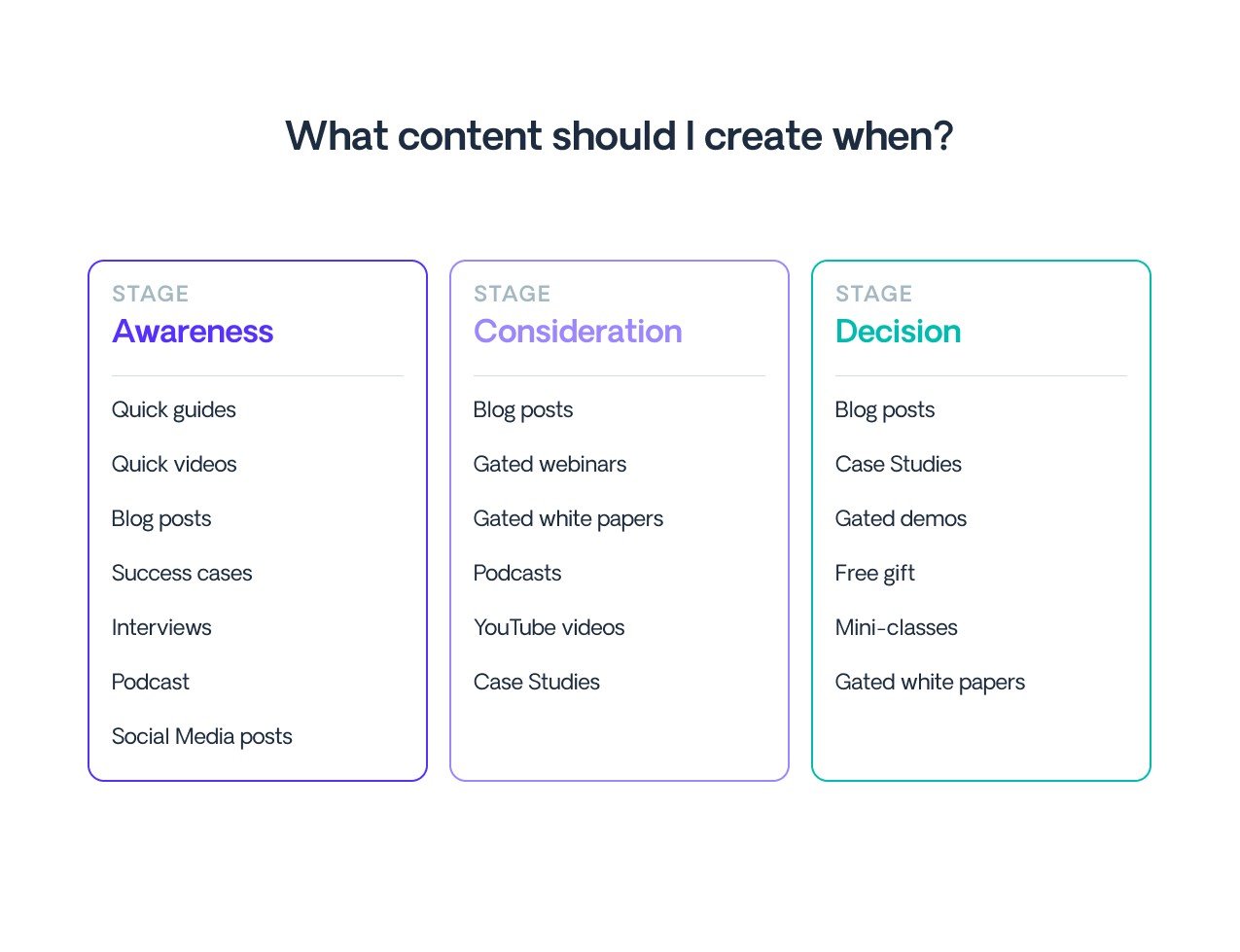

In other words, quality content marketing can – and should – be one of the channels to use to promote your products and generate leads.
For those of you who haven’t yet started working on their CBD content marketing, and more specifically on their blogs, I have this bar graph from Ahrefs that shows the number of pages on CBD that Ahrefs has in its index and – as you can see – there’s an increase.
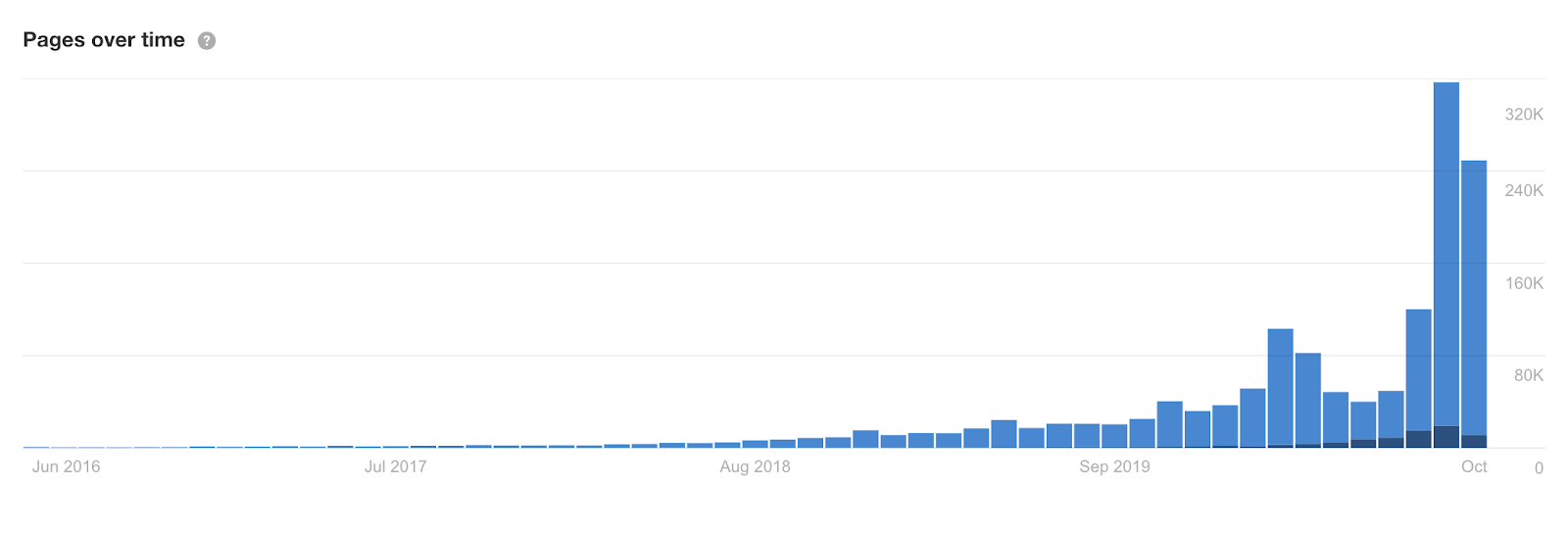

Author’s Note: Even though Google’s index is bigger than Ahrefs’, what we see above is the fact that the number of pages created around CBD are increasing and thus competition around the term is increasing as well.
Why is this important, you may ask?
Because it shows us that the topic is now trending and there’s a great opportunity for CBD brands to start building on their online content.
In other words, increased competition means increased demand and vice versa.
As you can see below, informational blog posts that focus on transmitting valuable information on CBD products and benefits score high in terms of organic traffic and traffic value, and even for the number of referring domains (AKA links).


Author’s Note: Learn more about the metrics mentioned above in this guide on how to use Ahrefs.
In addition to this, the graph below by Exploding Topics shows us the impressively increasing rate of interest on the topic.


We therefore understand that content marketing is one of the most important channels to use for your CBD brand because people actually want to know more about the industry as a whole, and CBD derivatives specifically.
Moving on to the second channel.
Influencer marketing is another channel I definitely recommend you should use to make sure your CBD brand gets noticed.
Let’s first see a definition of influencer marketing:


Influencer marketing basically means that a brand is teaming up with an influencer, a person with a large following online and on social media.
In other words, an influencer can be pretty much any person that’s influential to a large number of people that are willing to try, buy, and start using products and services because they trust and admire the influencer.
The following bar graph shows that influencer marketing can generate positive returns on investment (ROI) with the majority of marketers stating that influencer marketing is better or comparable to other marketing channels.
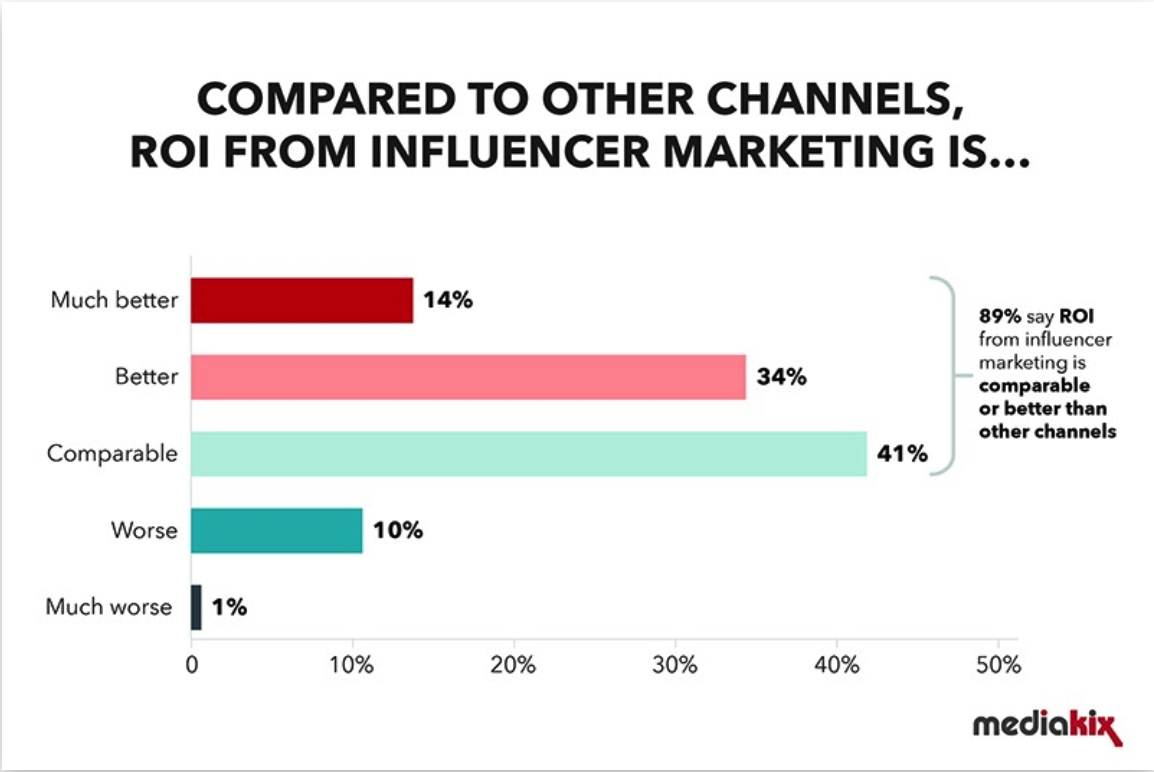

However, my advice would be to take extra care when deciding on the influencers you are going to partner with.
In other words, for influencer marketing to generate sales and leads it needs to target the right audience.
Additionally, it’d be very beneficial to team up with influencers who are actively creating content that’s to do with cannabis, wellness, therapeutic herbs, organic cosmetic products, etc.
Put another way, although it’s not necessary to team up with a specialized cannabis influencer – although, by all means do if you want to! – it can make a huge difference to approach someone whose audience is already familiar with such products and is successfully interacting with the content.
Take a look at data like the audience demographics, preferences, buying habits, and overall lifestyle to see whether teaming up with this influencer will be beneficial for your CBD business.
Let’s now discuss another available marketing channel.
The third valuable marketing channel we suggest you should use to promote your CBD brand is affiliate marketing.


Simply put, an affiliate marketer makes sure to promote specific products and lead people to buy them using their links.
The infographic below shows us how affiliate marketing works:
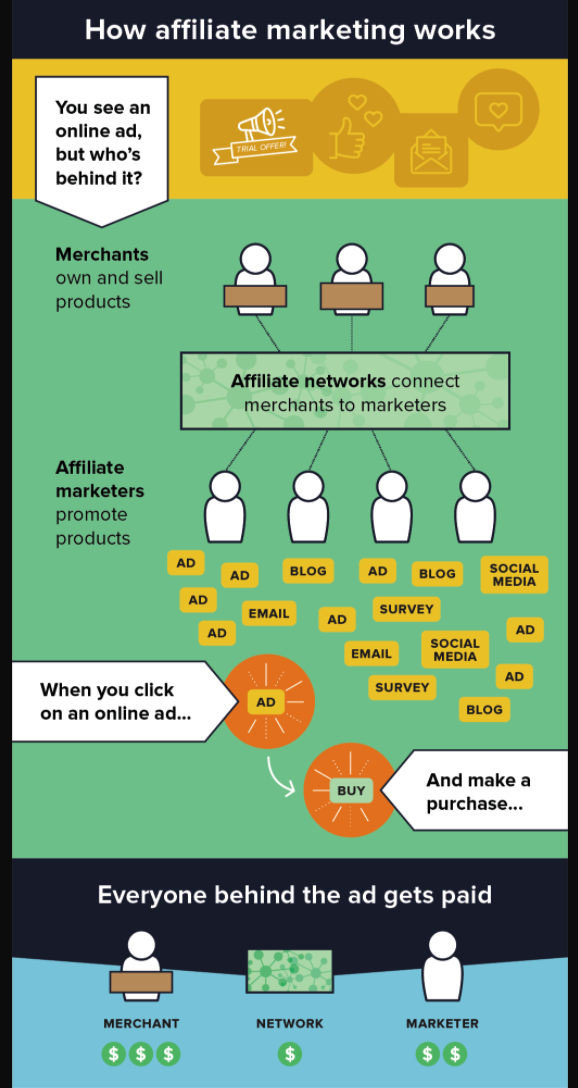

Affiliate marketing is a win-win for the affiliate marketer and the brand.
Given the restrictions we discussed a little further up that CBD brands have to face in terms of their marketing efforts, we think affiliate marketing can be a useful channel because it helps you promote your products and, most importantly, create an affiliate network that will – in a way – work with you towards making your brand reputable.
To work with affiliate marketers and build a successful affiliate network you need to do what you’d do with influencers: approach the right people and make sure their audience is familiar with such types of content and products.
In other words, team up with affiliate marketers that are known for working with well established and high quality brands because this will make you stand out from the competition almost immediately.
Keep reading to find the second to last marketing channel for your CBD brand.
Email marketing might sound a bit old-fashioned to some of you, but trust me when I say it’s not!
Email is one of the most used and well-established marketing and communication tools around the world.
According to Statista, there’s over 300 billion emails sent and received on a daily basis in 2020, thus proving the extremely high level of popularity of the channel.
Have a look at the bar graph:
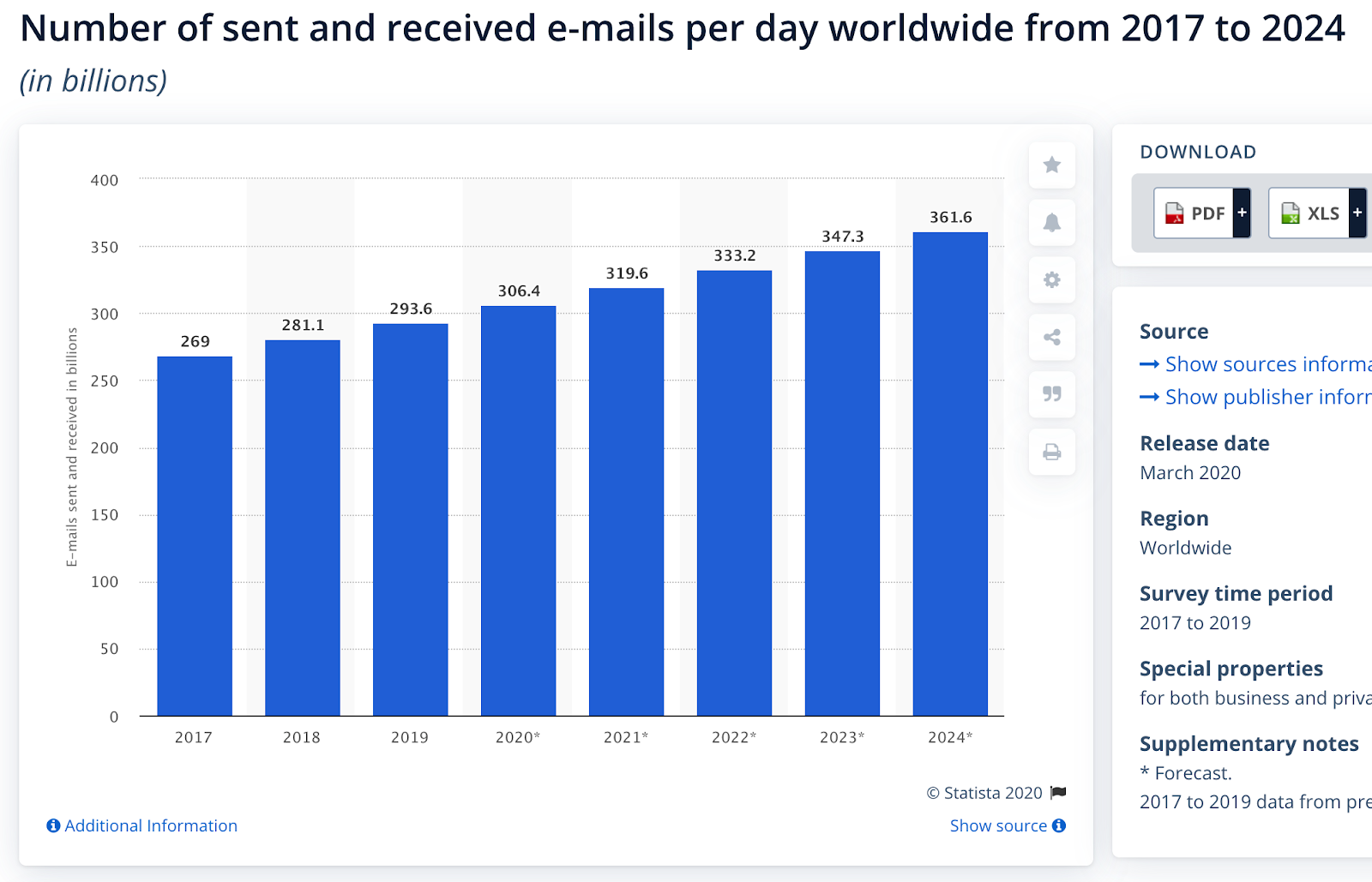

As if the numbers weren’t high enough, the number of daily emails worldwide is expected to increase and reach over 350 billion.
The number of emails sent and received is, of course, in relation to the number of users that, again according to Statista, is expected to reach around 4.5 billion users in 2024.
We understand that email marketing is a channel that can help you stay connected to your audience.
You can consider using your newsletter to send out important information and valuable content that’ll make your audience more familiar with what you offer and more likely to buy your CBD products.
Additionally, your newsletter could include dynamic content, product reviews, product recommendations, recipes, and new product announcements.
All these are very likely to drive readers to your website and specific landing pages where they’ll find more information and relevant products.
Moving on to the final marketing channel on this list.
The final marketing channel I have for you is search engine optimization (SEO).
Before I say anything else, I’d like to show you some mind-blowing data on the numbers of Google searches per second, minute, hour, and so on and so forth.
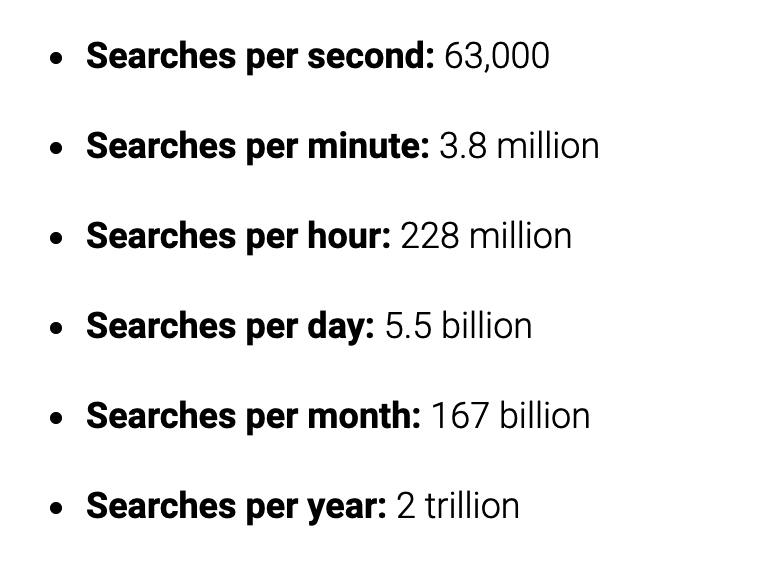

What the numbers show us is that search engines, and especially Google, are an extremely important part of our online activities.
Focusing on your SEO can be one of the most efficient ways to lead organic traffic to your website, thus raising awareness of your brand.
In other words, SEO can be efficient and cost-effective, as the graph below shows:
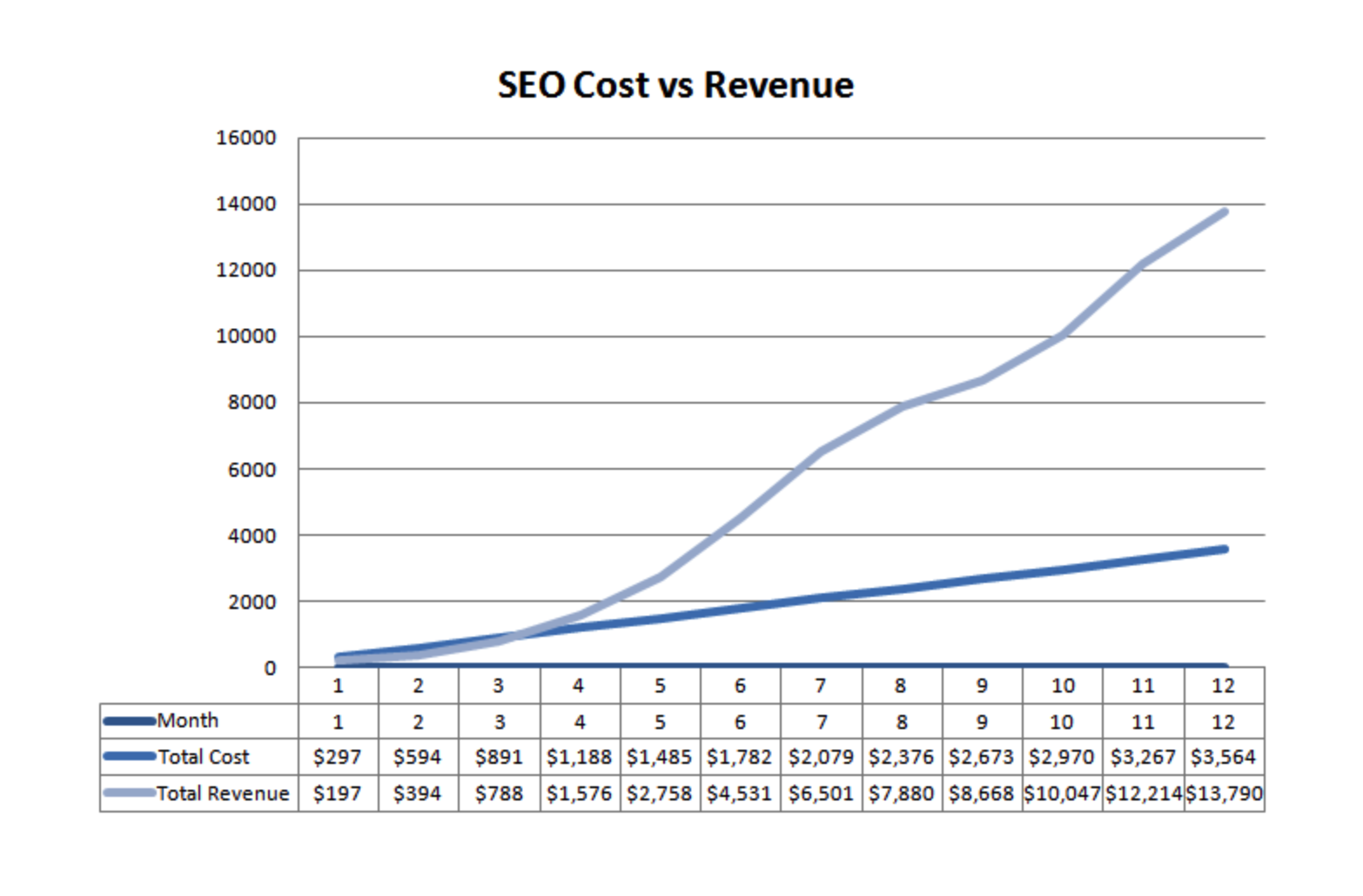

When it comes to using SEO for your CBD brand, you should keep in mind that although SEO is indeed a marketing channel you could, and should use, you need to make sure that you’re not making any medical claims or any other claims that could be a problem in a potential FDA investigation.
We’ve made it to the end of our discussion on the available marketing channels for CBD companies, let’s now discuss what your options are when it comes to marketing your business.
After having talked about the restrictions and available options, we’re going deeper into the options you have when it comes to marketing your CBD business.
Here are the main differences between the two main options for marketing CBD products:
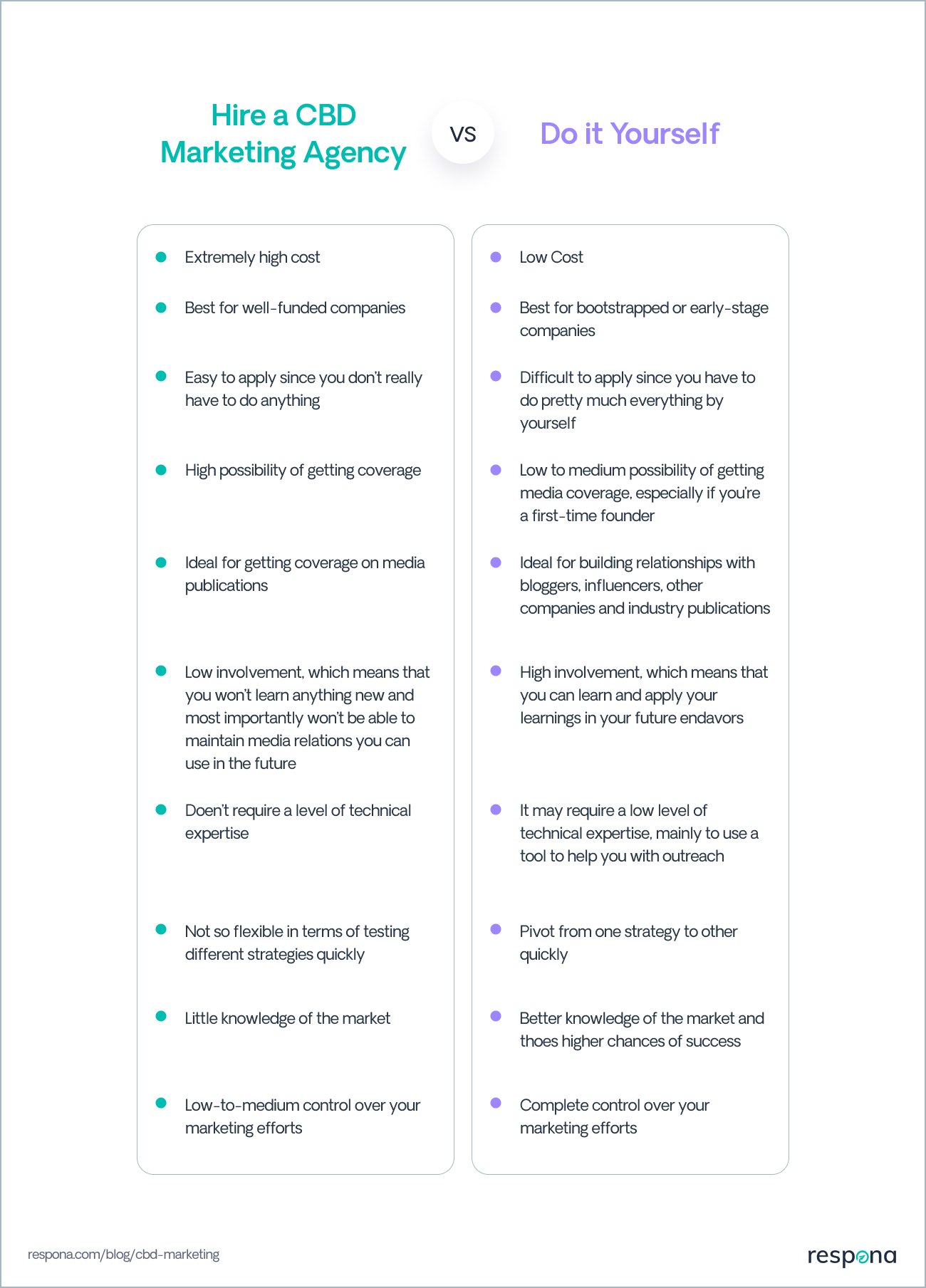

The first option would be to do it yourself, which is recommended mainly for bootstrapped and early-stage brands.
There’s a wide range of benefits in marketing your CBD business yourself.
First of all, it’s cost effective which means that it’ll be way cheaper than hiring an agency or a marketer.
Additionally, doing it on your own allows you to understand and learn more about the industry you’re in, thus making it more possible for you to make the right decisions in the future and take advantage of what you’ve learnt in order to grow your business.
More than that, it gives you the freedom to control your marketing efforts and make changes when something might not be working properly or at all.
On the other hand, there’s some important disadvantages that might make you want to ask for some help.
The main one is that you might find it difficult and time consuming to apply all the marketing tactics you’d like to apply, given that you’ll have to do everything on your own.
Also, some helpful marketing tools, e.g. outreach tools, might need you to have some sort of technical expertise in order to be able to use them effectively.
In addition to the high level of involvement and technical expertise, there’s a great chance that your efforts won’t get noticed on the level that they should be seen, or they might not reach a very broad audience online.
Let’s now discuss the second option.
Your second option would be to hire a CBD marketing agency; an option which is more appropriate for well-funded companies.
The main advantage of getting a specialized CBD marketing agency to work on marketing your business is that you have great chances to get media coverage while not having to put valuable time into applying marketing tactics.
The agency will do it for you!
Additionally, hiring an agency doesn’t require you to have any level of technical expertise.
It also means that you won’t have to worry about the right strategies because you’re not going to be in control of them.
However, not being personally involved in the marketing efforts that your company is applying might have a few disadvantages.
For example, your low involvement will most probably keep you away from being up-to-date with what’s going on in the market, including the fact that you might not be maintaining important media relations that can always be useful.
With this, I don’t mean you shouldn’t hire an agency, just that if you do, try to remain active and connect with your industry because this can really make a difference in the way you market your brand in the future.
I’m now going to take you through the process of launching a CBD marketing campaign.
We saw that, when it comes to CBD marketing, your options aren’t really limited, as long as you know what channels to use.
For the purpose of this guide, we’ll be assuming that the campaign that we want to launch involves outreach.
In other words, we’ll be reaching out to other websites to promote our CBD oil business.
For this reason, we’ll be using Respona, a modern outreach software that allows you to:
For our hypothetical campaign, we’ll be using Respona to find list posts with the best CBD oil companies to be featured in.
Let’s get into it.
The first step is to start a new campaign with Respona.
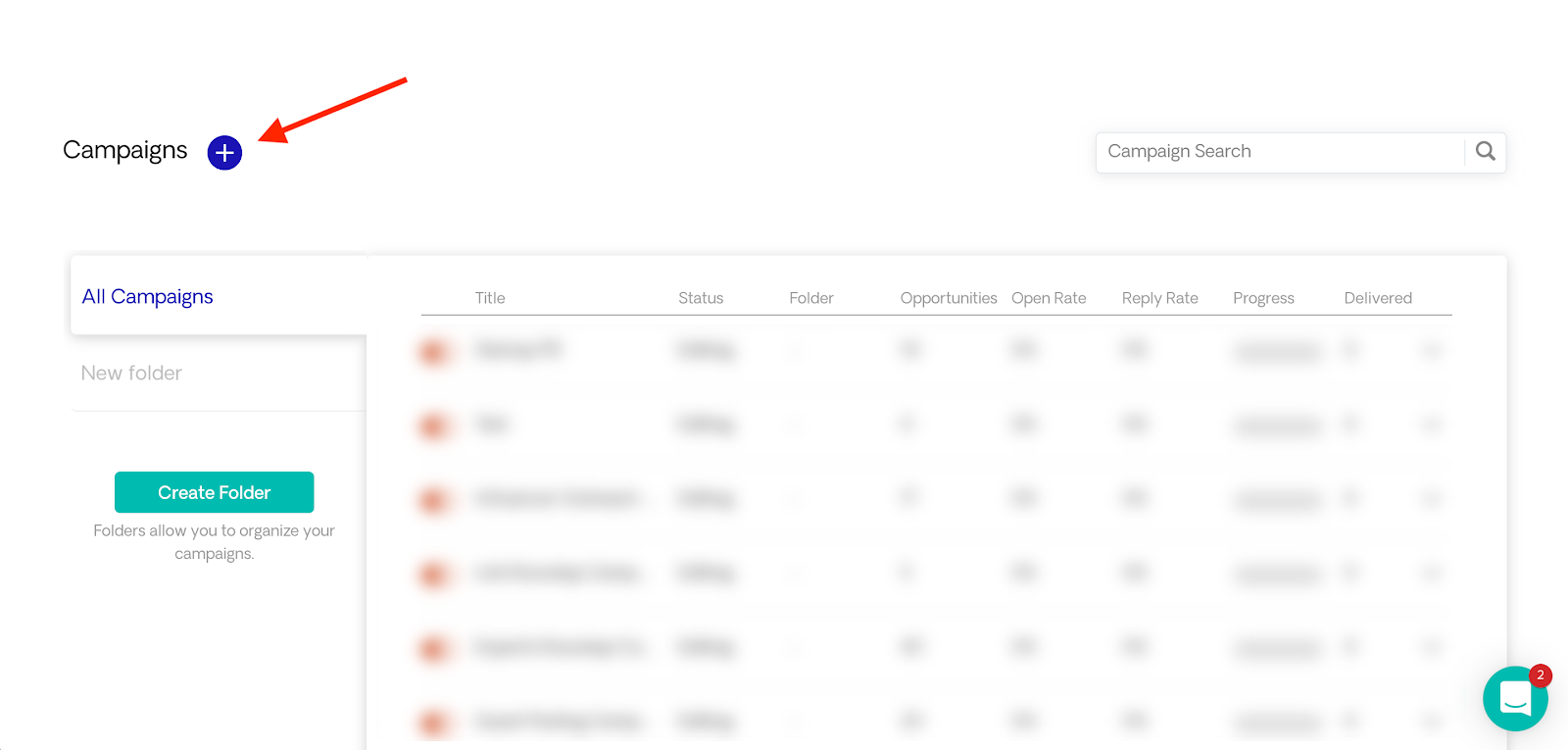

Then, you need to give your campaign a name and click on “Create”.
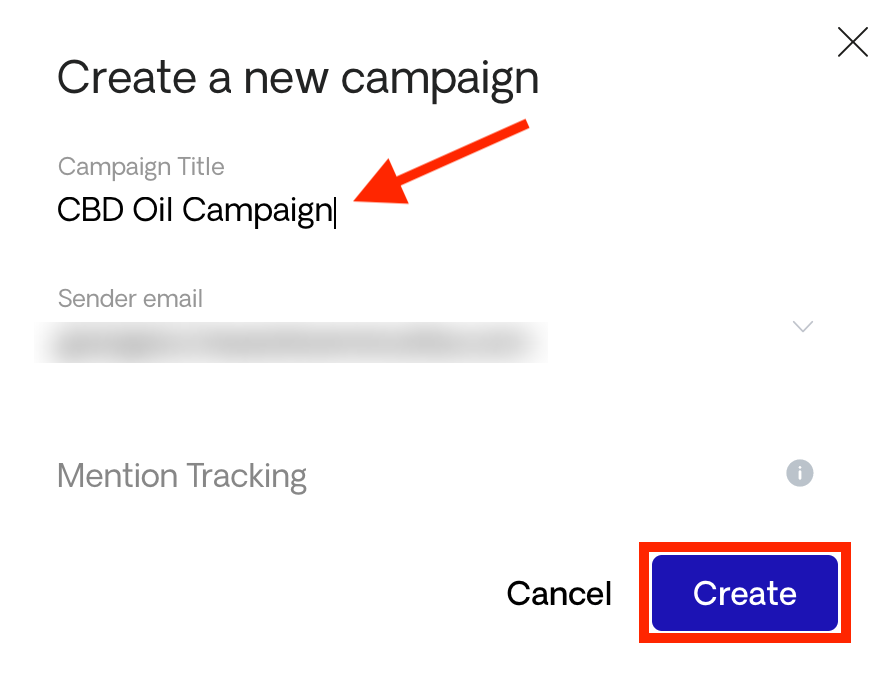

Author’s Note: Make sure to give your campaign a name that’s easy to understand by different stakeholders within the company and use identifiers like; the audience, if you’re targeting different ones; the content name if you’re doing outreach to promote a content piece; or the month/date if you’re running and generally managing several campaigns.
With Respona, you can build a campaign using one of the following methods:
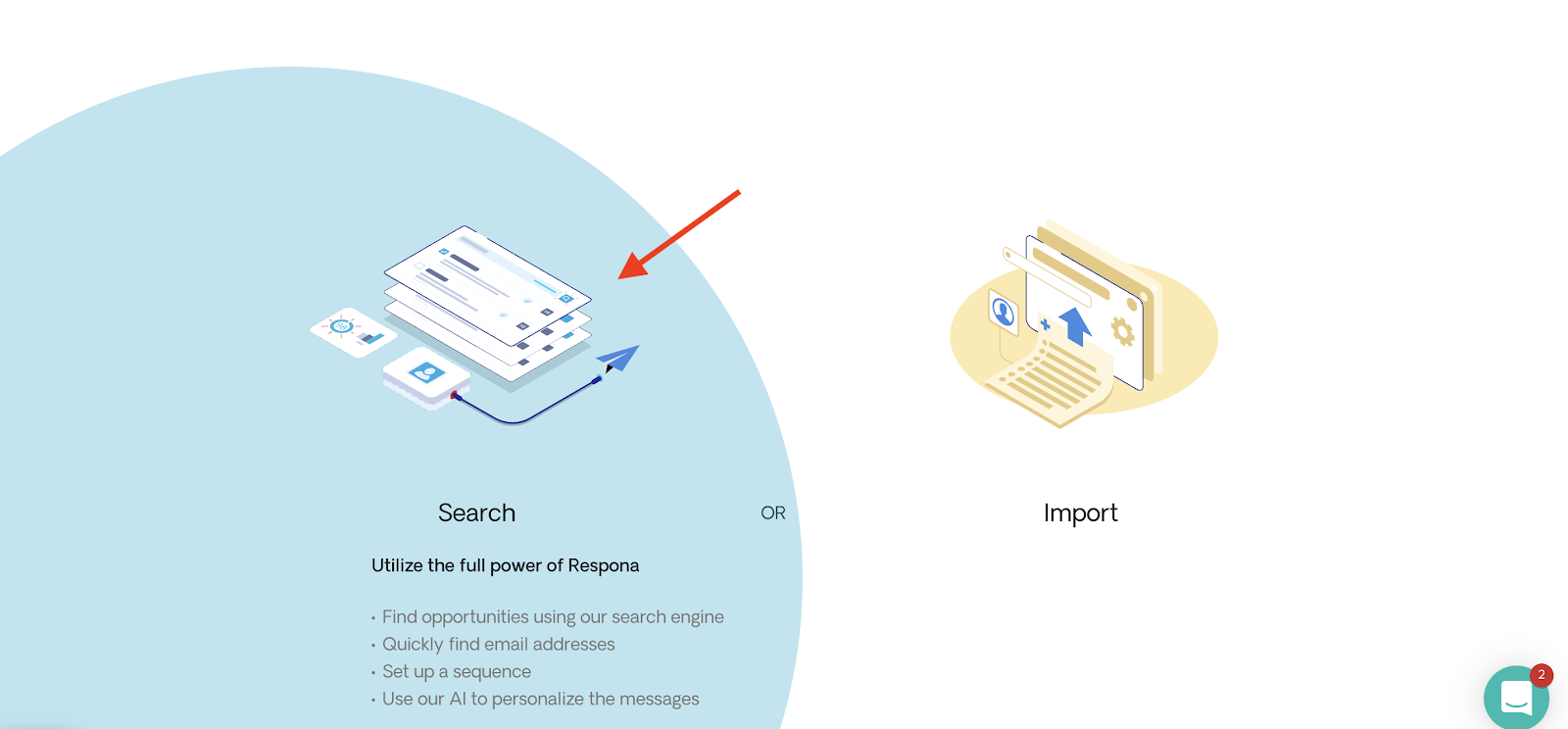

Author’s Note: Respona’s search engine results are powered by Bing so you may notice some differences between results in our search engine and other search engines like Google.
For the purposes of this campaign, we’re going to choose the “Search” option.
Next, we need to find opportunities for our campaign using Respona’s search engine.
To do that, we’re going to use the search bar — in exactly the same way we’d do a search on Google.
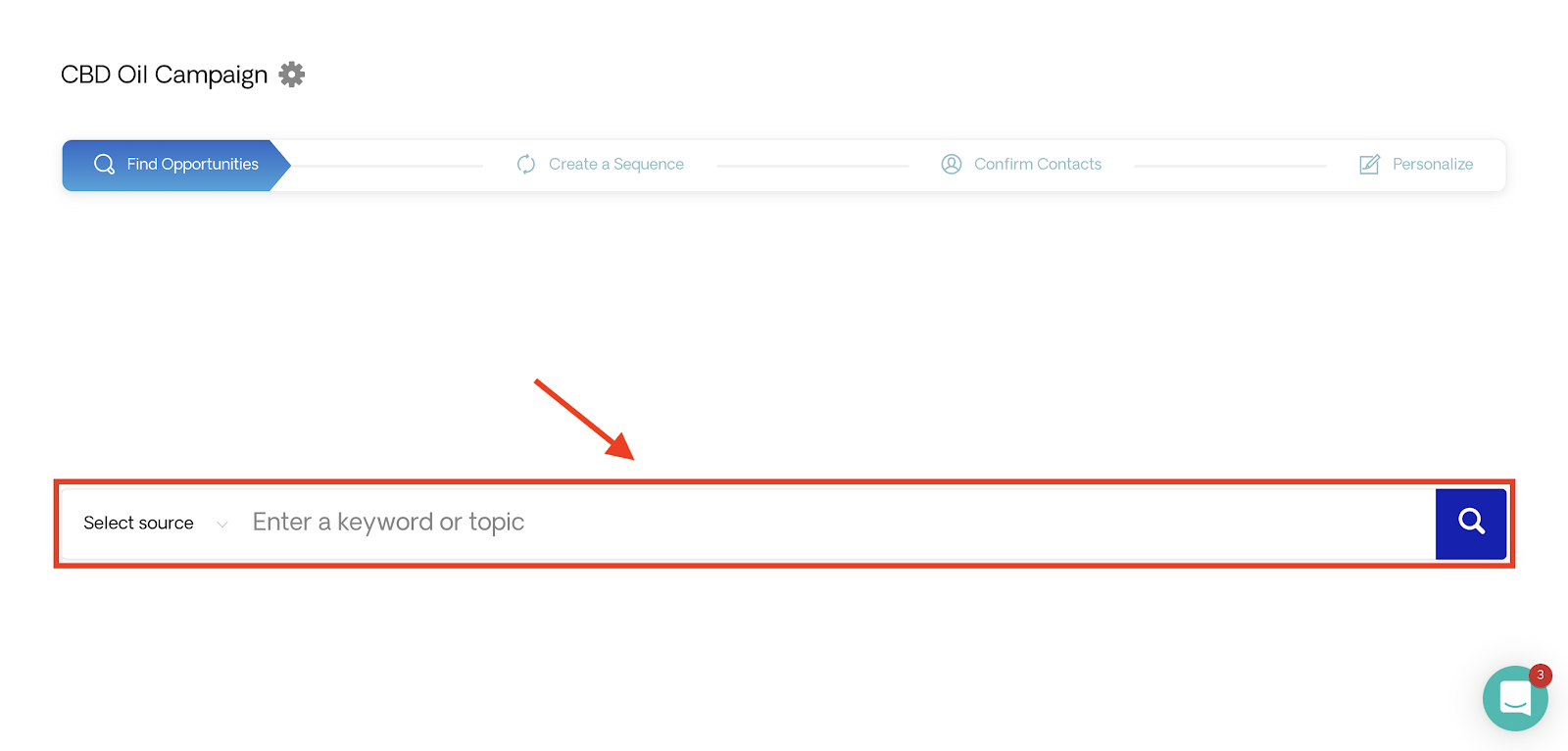

The good thing is that you can use Respona’s search engine both by inserting simple queries and by coming up with more complex search queries that include search operators.
For our example, we’ll be assuming that we want to run a CBD marketing campaign for a CBD oil company named BluPeak Botanics.
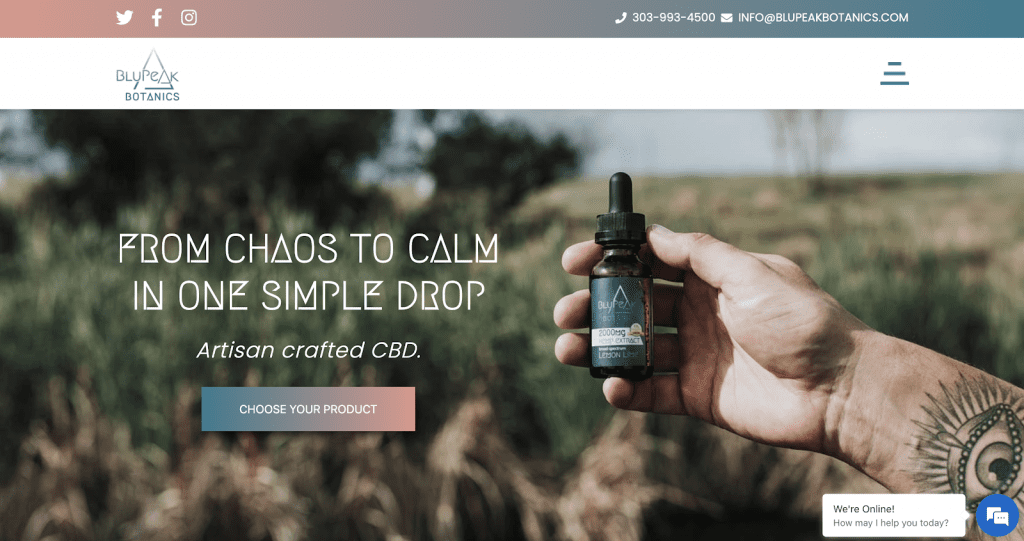

Naturally, we’d want to be listed in posts with the best CBD oil companies.
Thus, the term that we could use to begin with is “best cbd oil”.


However, if you think about it, that would return results that could have the term “best cbd oil” everywhere, e.g. the title and the text, and at the same time could have our company (BluPeak) listed there already.
We want to a) look for results that have the term “best cbd oil” in their title and b) don’t have BluPeak listed already.
Here’s what our search operator should look like:


The term best is just one of the search intent modifiers we can use.
Some other ones — that we can use separately or in conjunction with the one that we’ve chosen already — for this example are:
The last thing that we need to do is to choose “Blogs” as our source for this search.
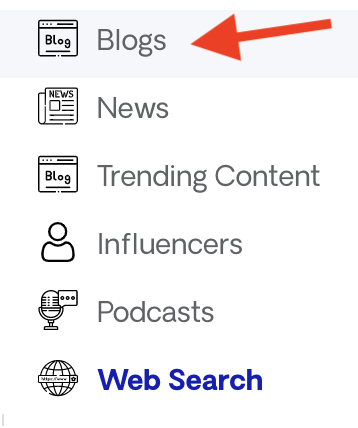

The reason why we want to do this is because most of the time, list posts listing different options for a particular service/product/product category live in blogs.
On top of that, choosing blogs will hopefully remove any product pages that include the term “best cbd oil” in their title tag.
This is what you’re going to see next:


Author’s Note: In most cases, Respona is able to identify many opportunities for a given search query. If the opportunities aren’t plentiiful, then you might as well try to use a different search operator.
As you can see below, each of the results displayed on Respona’s search engine have a blue link which is the title tag, a description of the page (AKA meta description), as well as an indexation date and the full URL path of the page.
You can visit any result by clicking on the blue link.
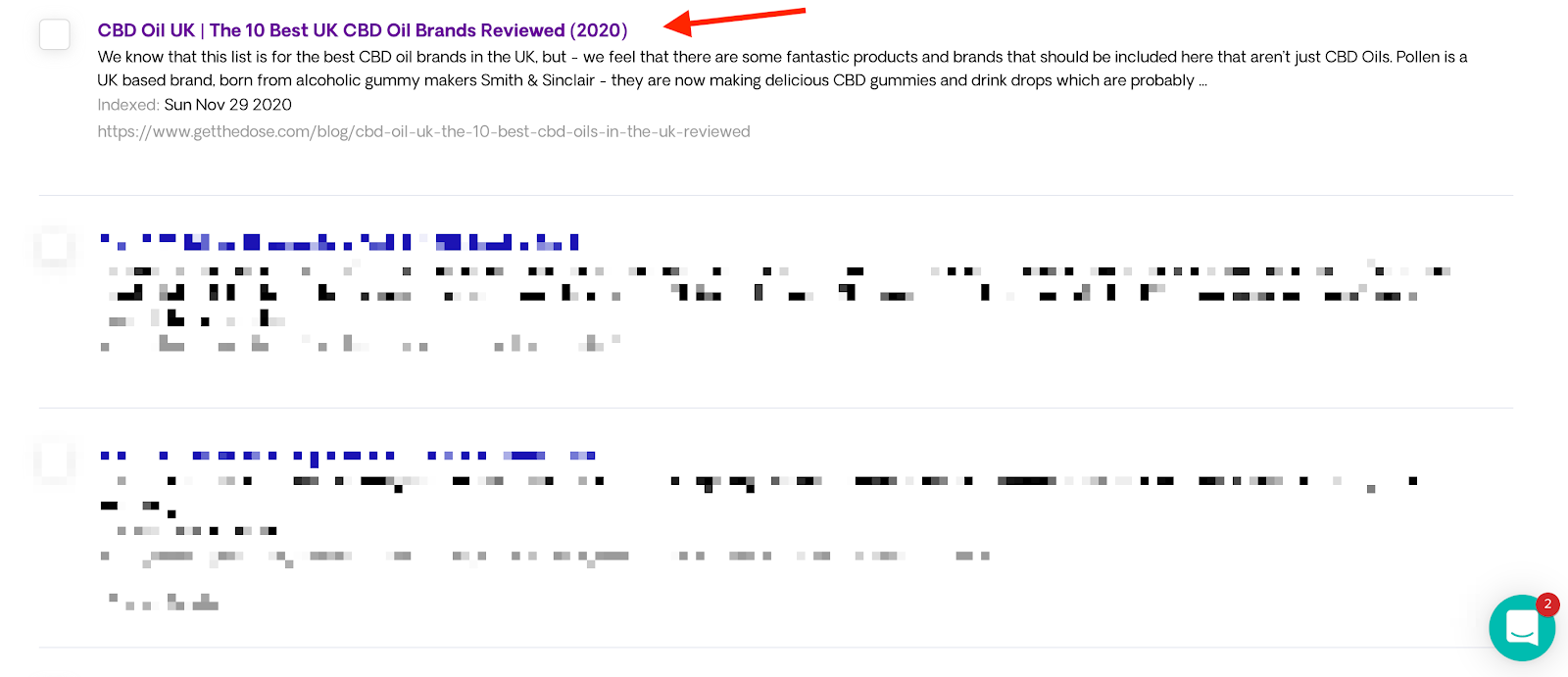

Here’s how one of the results that Respona found looks:
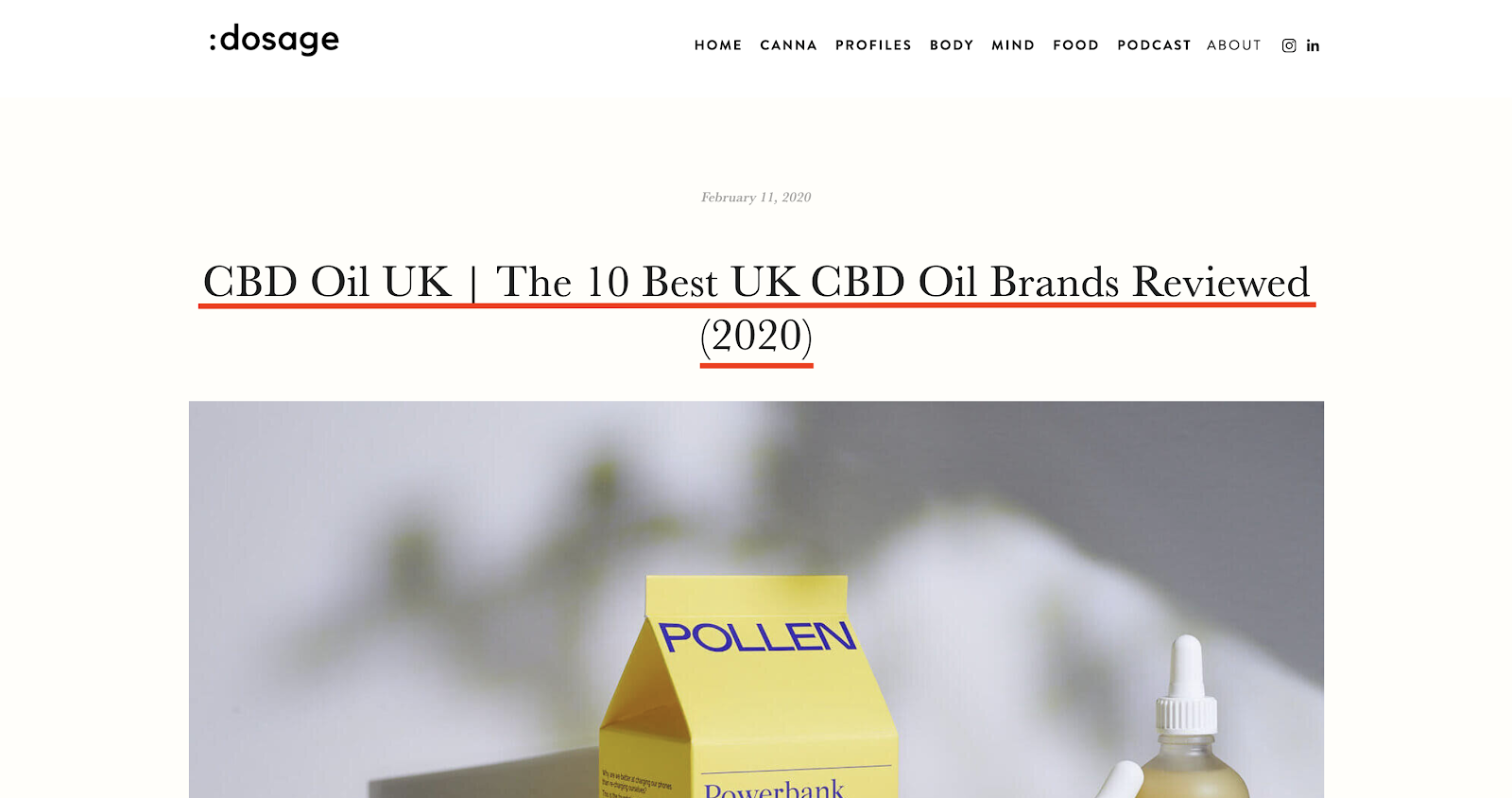

Image Source: dosage
This is a good opportunity because it comes from an authoritative website and is exactly the type of content we’d like to be featured on.
Some of the opportunities may not be as good.
Your job is to choose the ones that you believe are relevant to what you want to achieve through your campaign and choose each of them by clicking on the checkbox at the left of each opportunity.
When you’re done choosing opportunities, you’ll see the total number of selected opportunities above the search results.
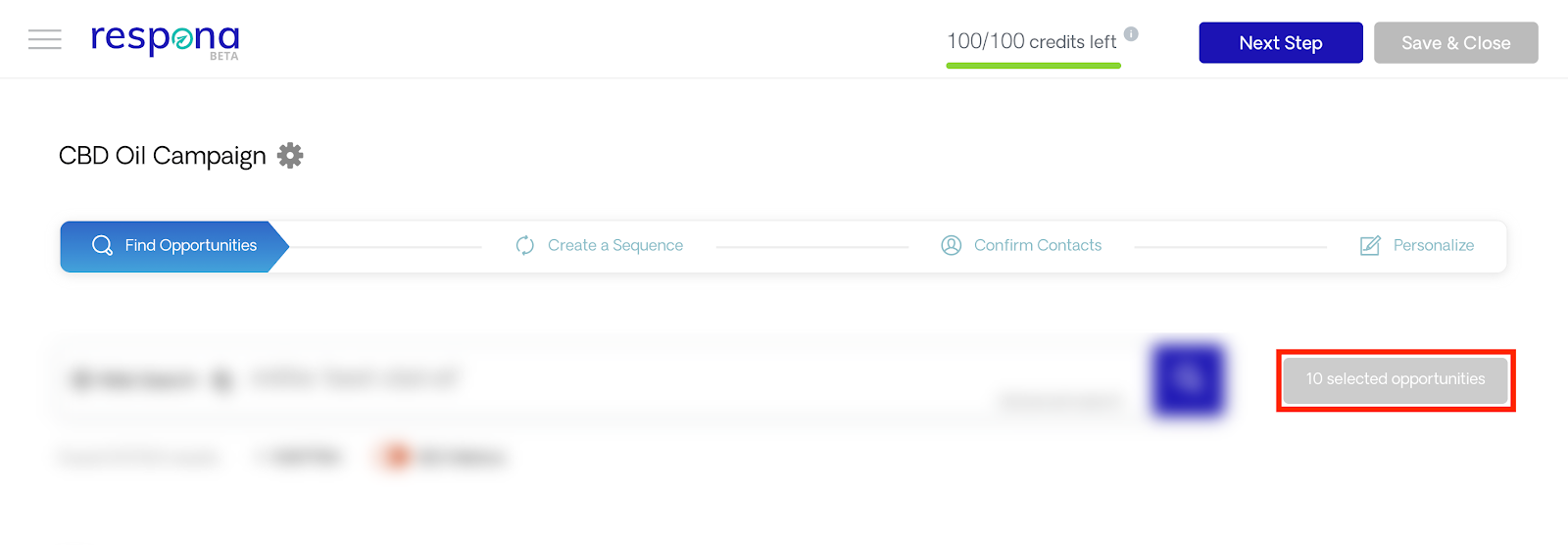

Author’s Note: In general, the more opportunities you select, the better. However, you have to make sure that these opportunities are indeed relevant to your goals and campaign objectives so that you can get the most out of your campaign.
When you’re done choosing the websites you’re going to reach out, you can click on “Next Step”.


What do you need to do next?
Prepare your email pitch.
Respona gives you two options when it comes to creating an email pitch:
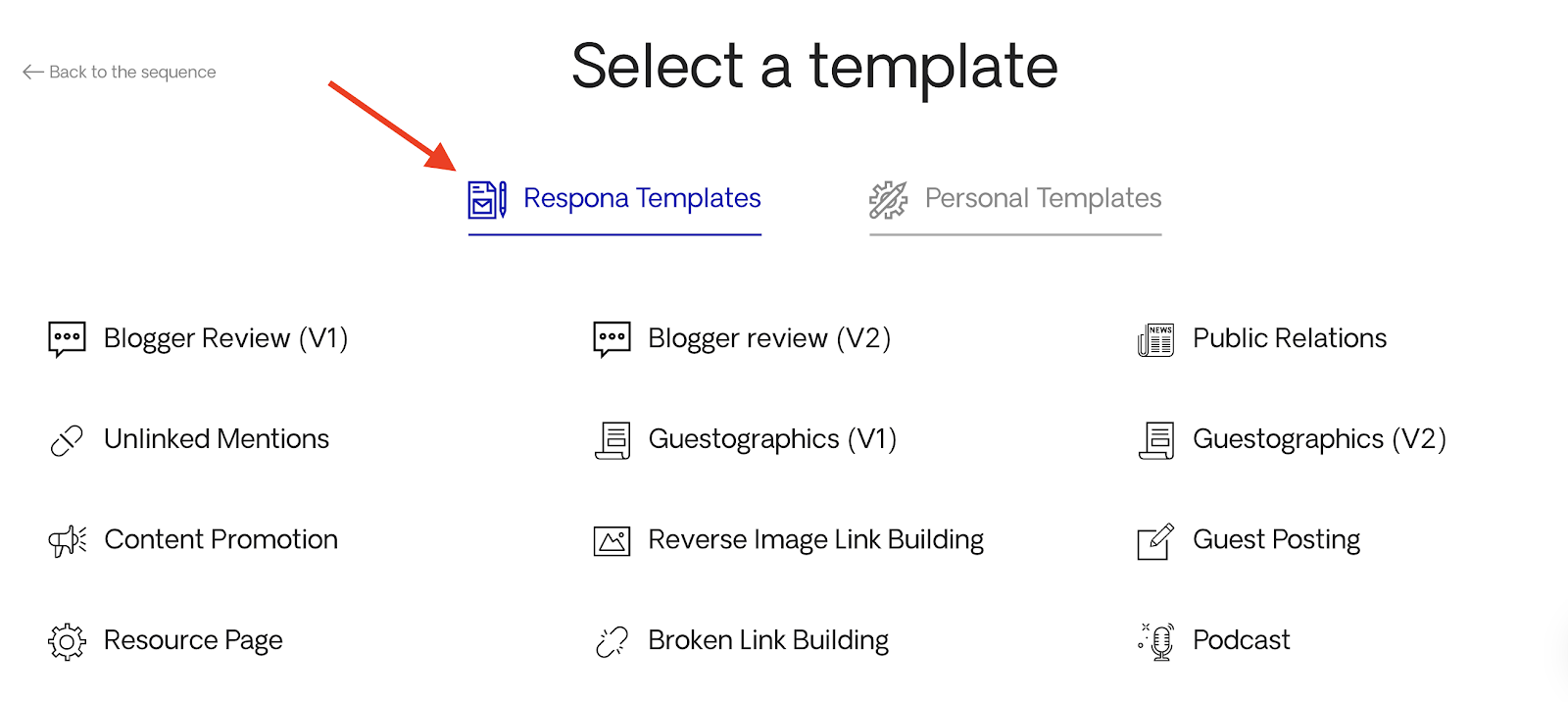

For this campaign, we’re going to choose one of Respona’s pre-made templates — the “Resource Page” one.
Here’s what the sequence looks like.
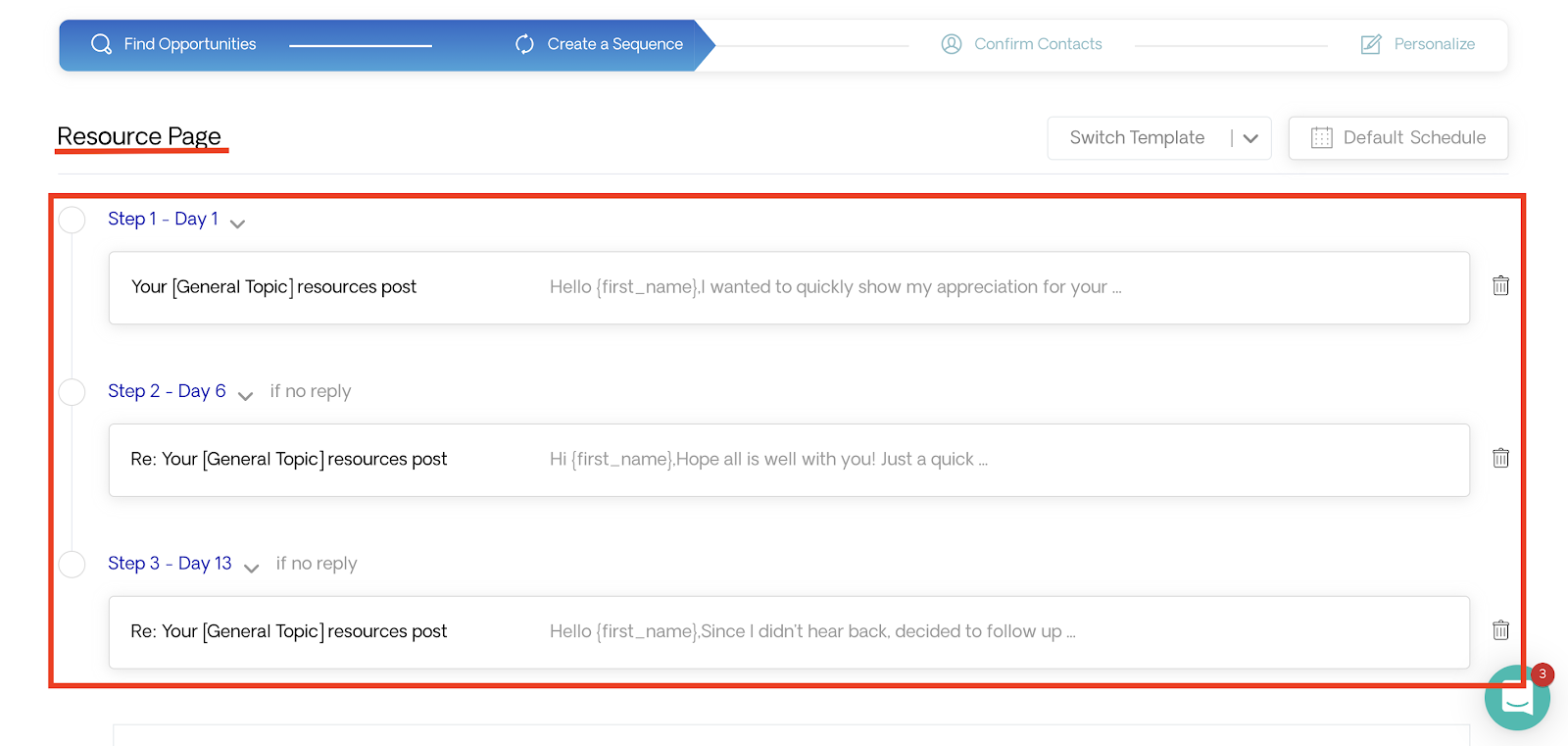

We have three emails, scheduled to go out on different days from the day the campaign starts.
Make sure to change the name of the sequence so that it’s related to the campaign you’re running every time.


Next, click on the first email of the sequence.
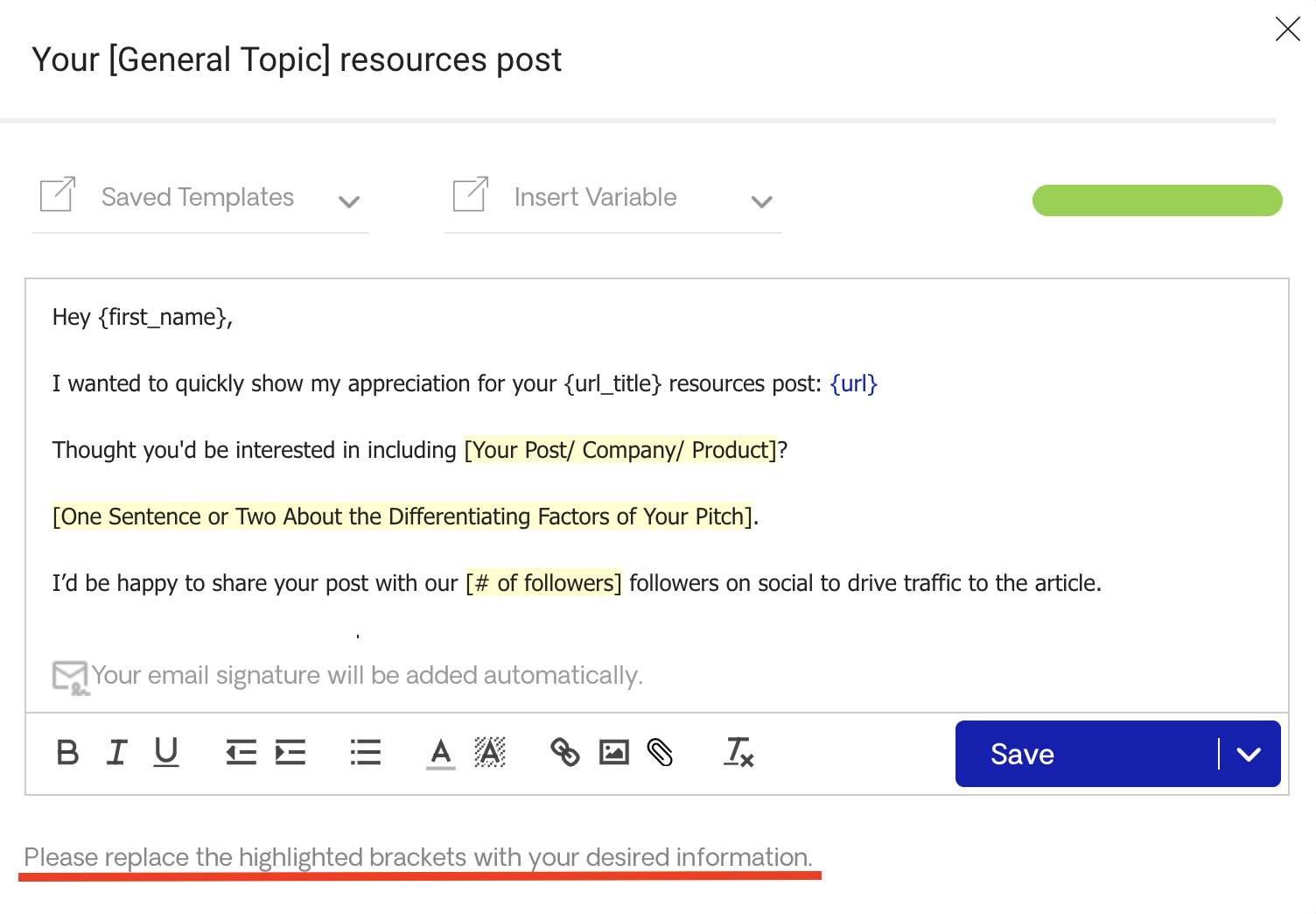

As you can see, there are certain pieces of text within brackets that are highlighted.
These are elements that we have to adjust for the purposes of our campaign.
The same applies to our campaign’s subject line.
We’ll start by changing the email subject line.
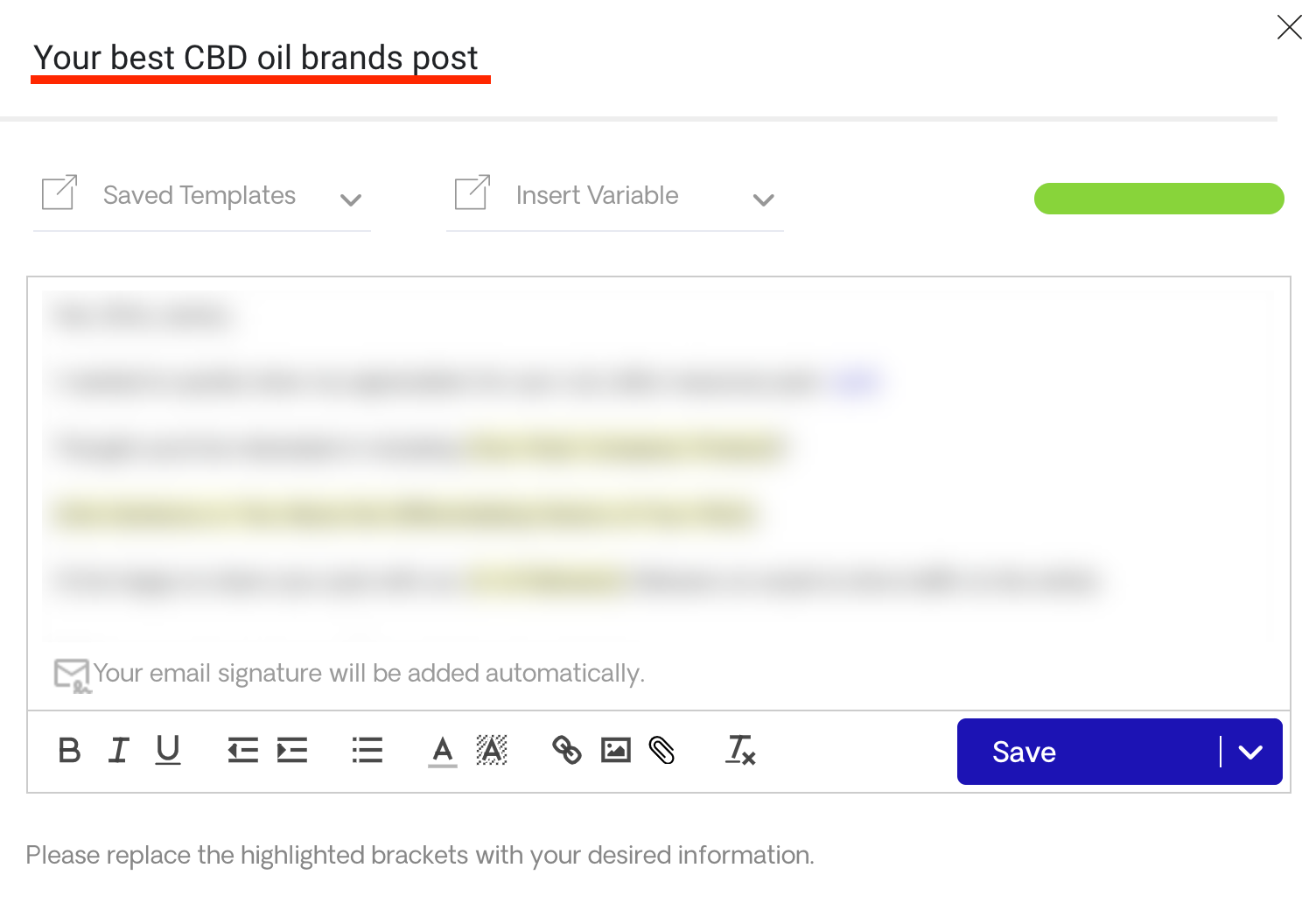

Author’s Note: Changing the campaign’s subject line in the first email of the sequence will automatically change the subject line in all other emails of the sequence.
Next, we’re going to change the highlighted elements with information that fit our brand and are aligned with the goals of the campaign.
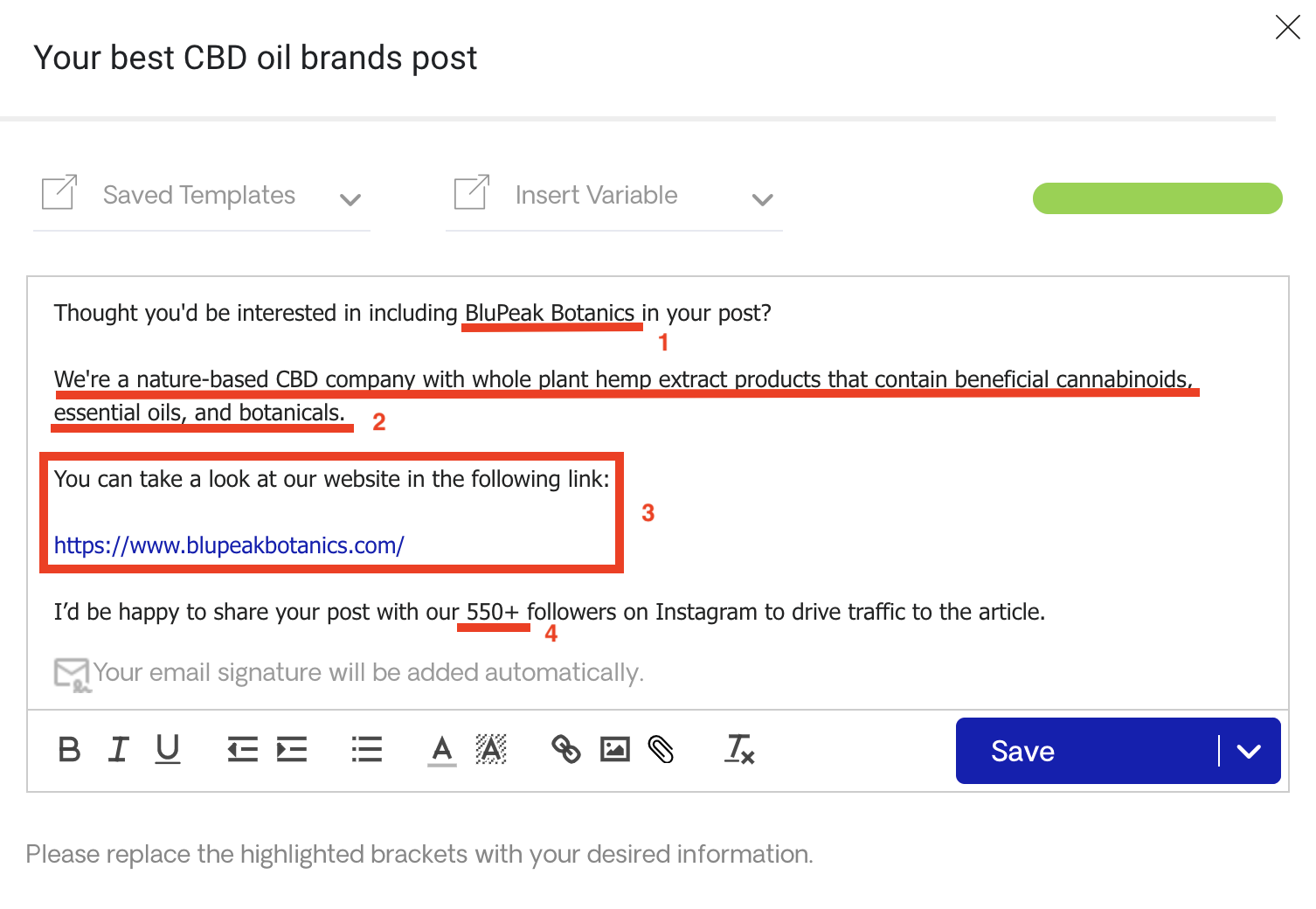

There’s really no limitation to what you can do here and what kind of additional information you can add.
Just make sure to not overdo it as your email will determine (up to a certain level) the success of the campaign as a whole.
Next to Respona’s email editor, you’ll notice a small window that grades your email as you make adjustments (both to the email body and the subject line).
As you can see below, our email has a high chance of getting a response based on the fact that we’ve followed all best practices recommended by Respona.
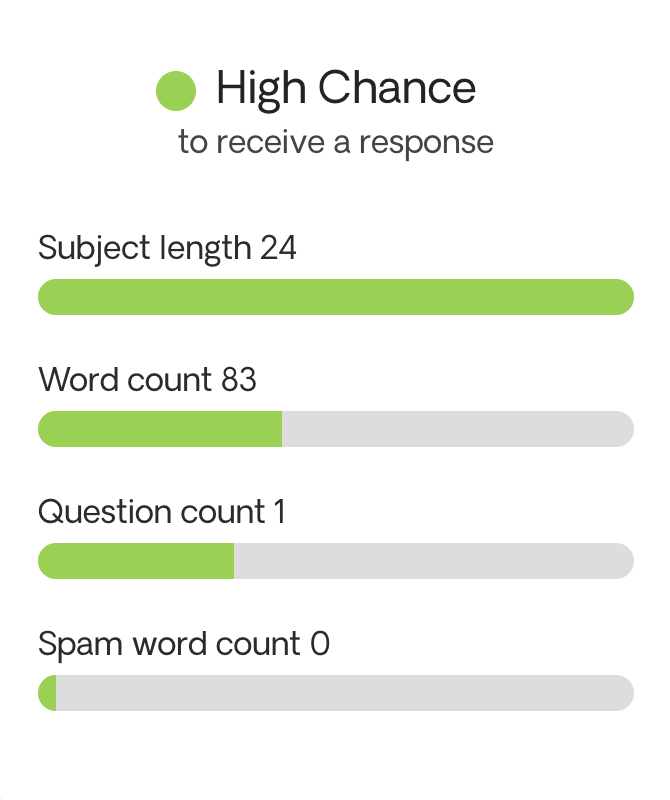

Once you’re done editing, you can click “Save”.
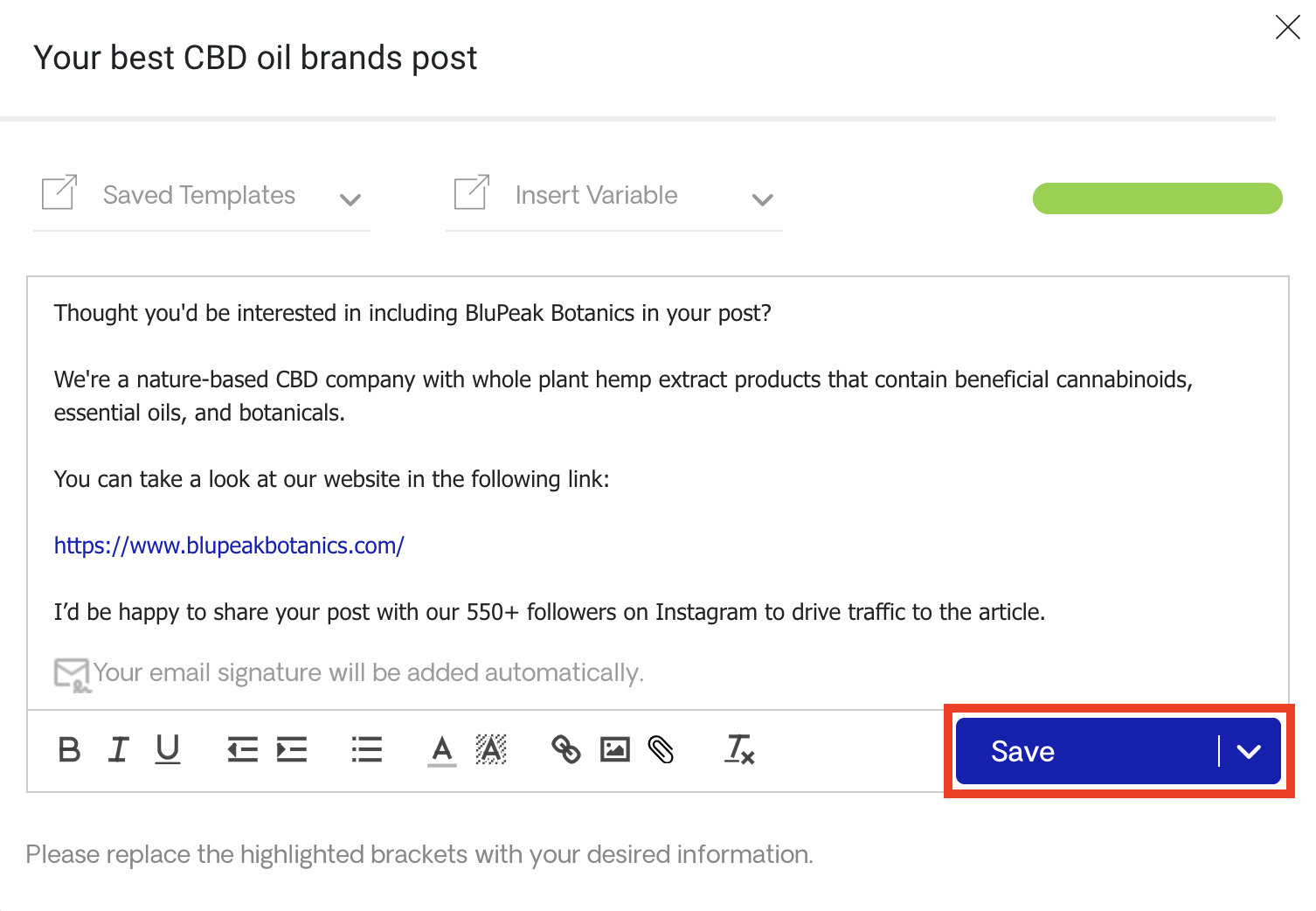

You’ll then notice that all the changes you made are now applied to the first email of your campaign.
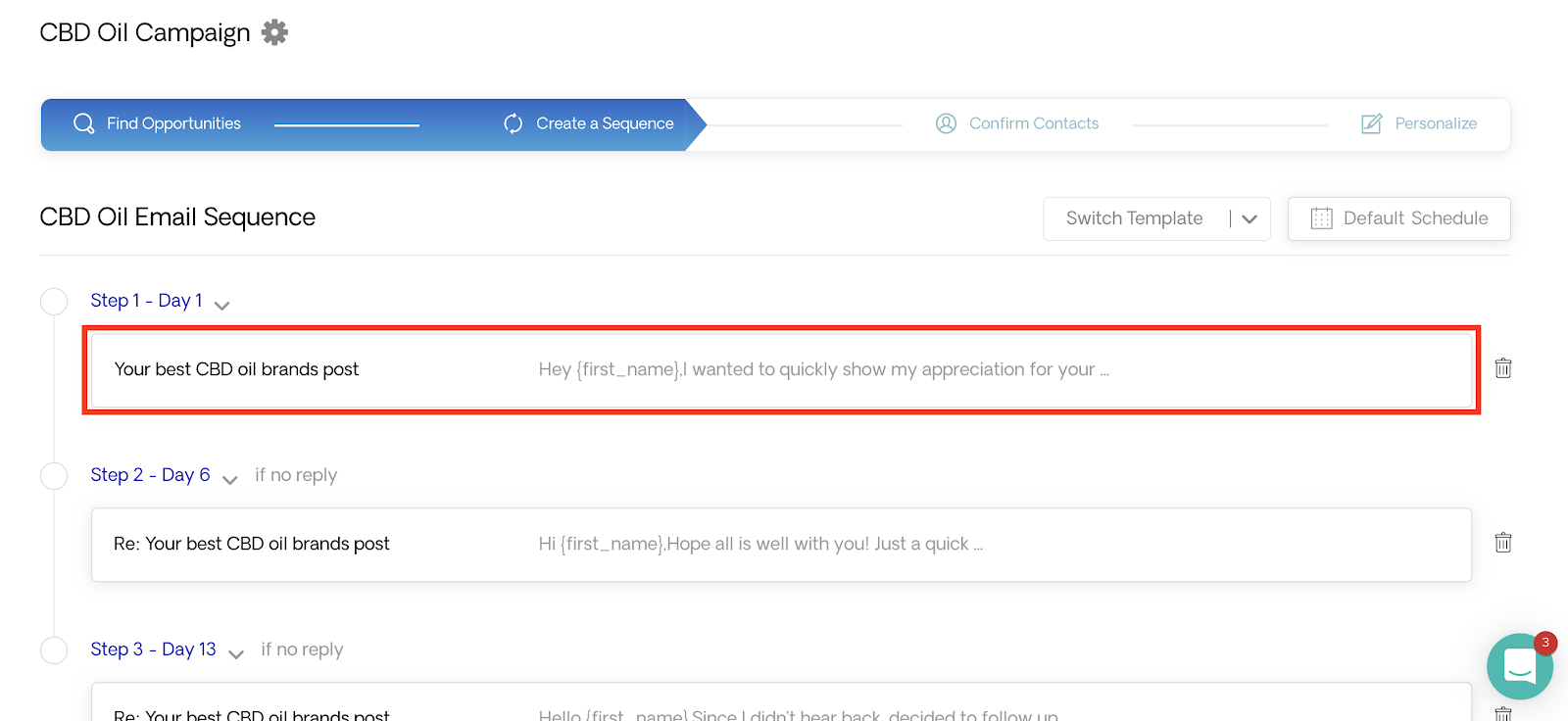

In the same way you edited and made changes to the first email of the sequence, you can apply changes to the second and the third email.
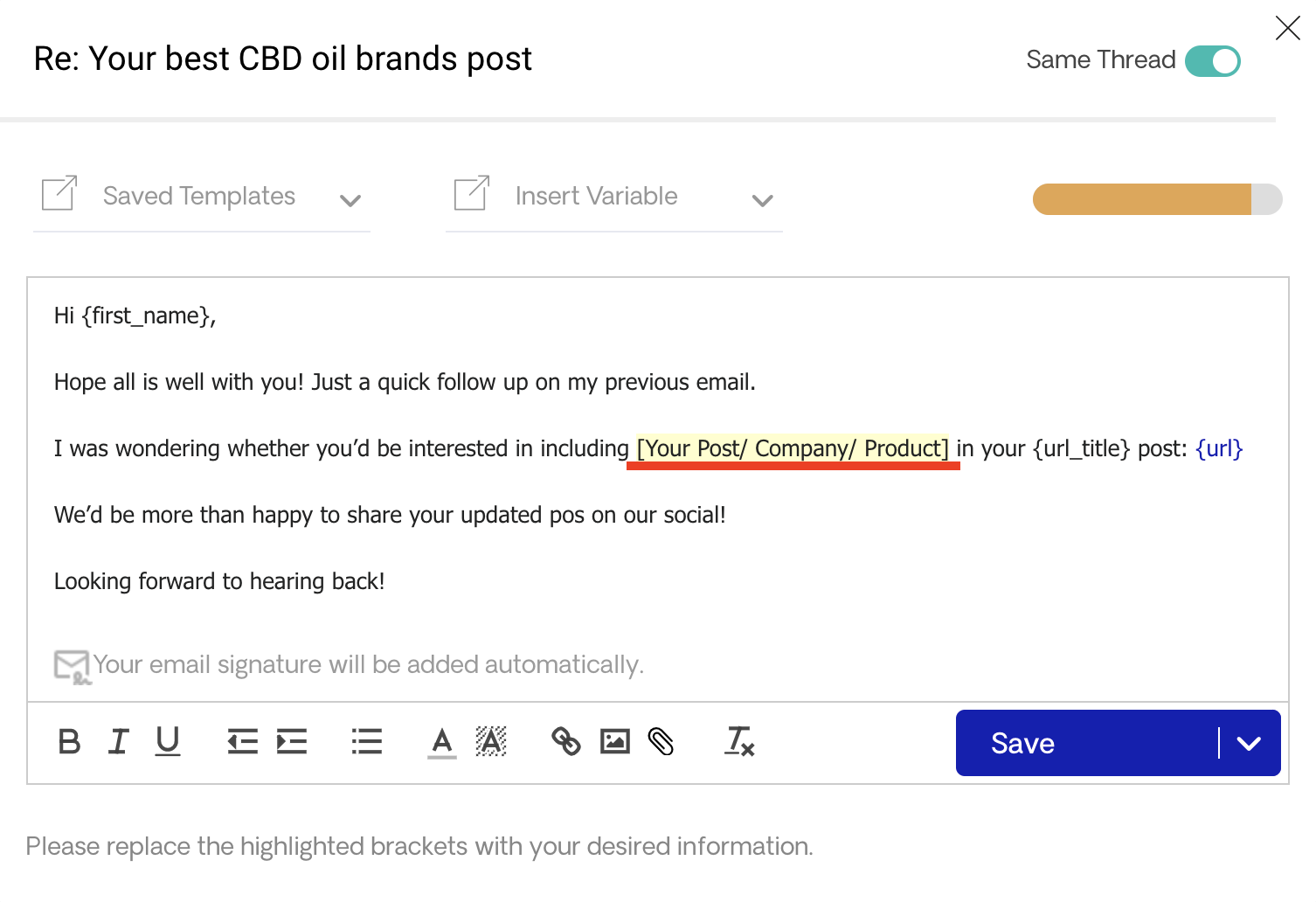

By default, the sequence we’ve chosen has three emails.
However, no one limits us from deleting one of the follow-up emails, so that you have only two emails.
You can do that by clicking on the trash icon next to each email of the sequence.
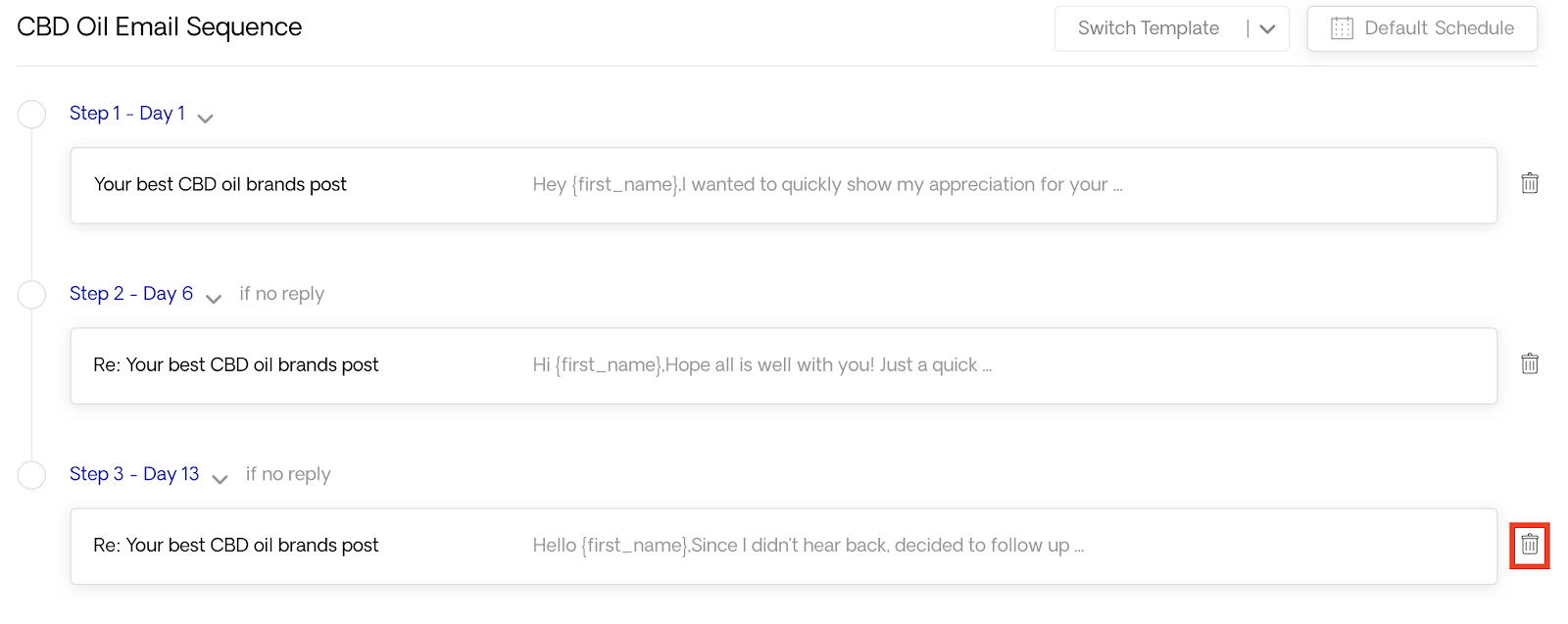

When you’re done editing your email and preparing your pitches, you can click “Next Step”.
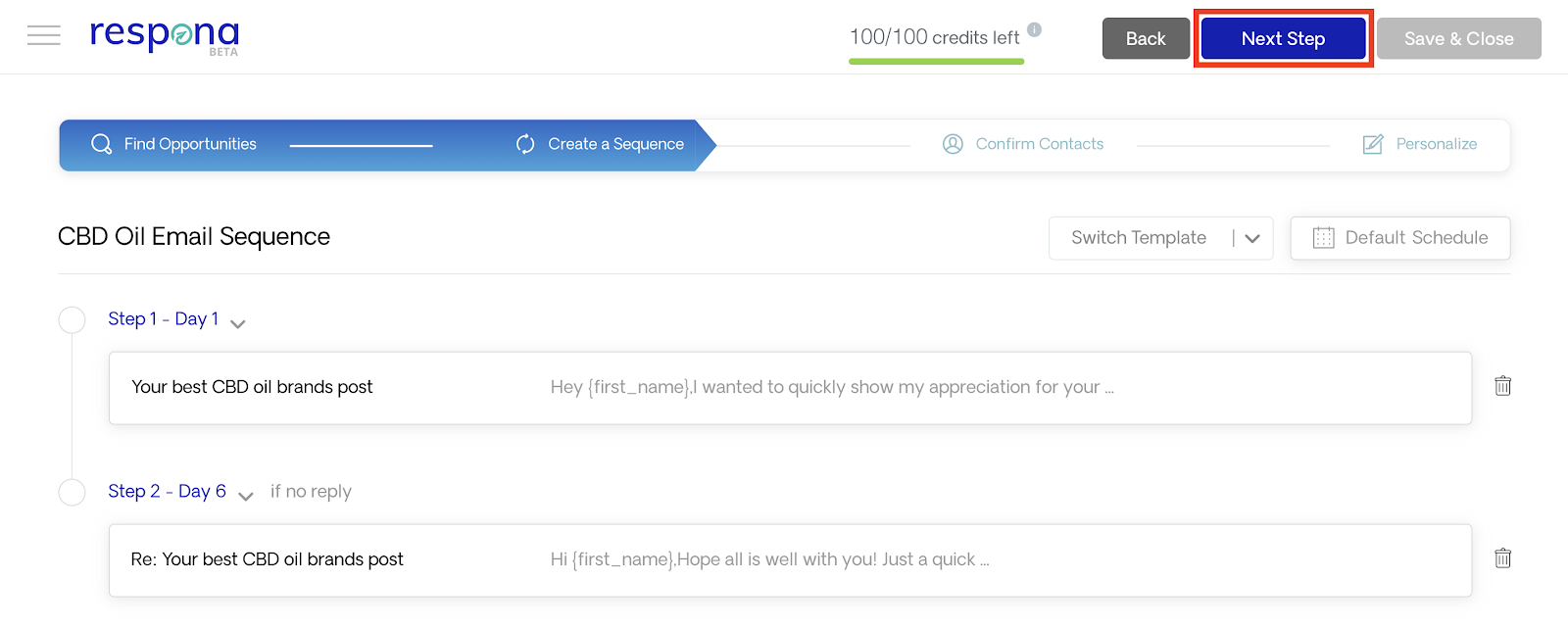

What do you have to do next?
Find the contact information for your campaign prospects.
You’ve found the opportunities you want to reach out to and you’ve created the email sequence you’re going to use.
The next step is to find the contact information of your prospects.
You can do that easily with Respona.
The first option we need to choose is where Respona should assign opportunities to authors of URLs.
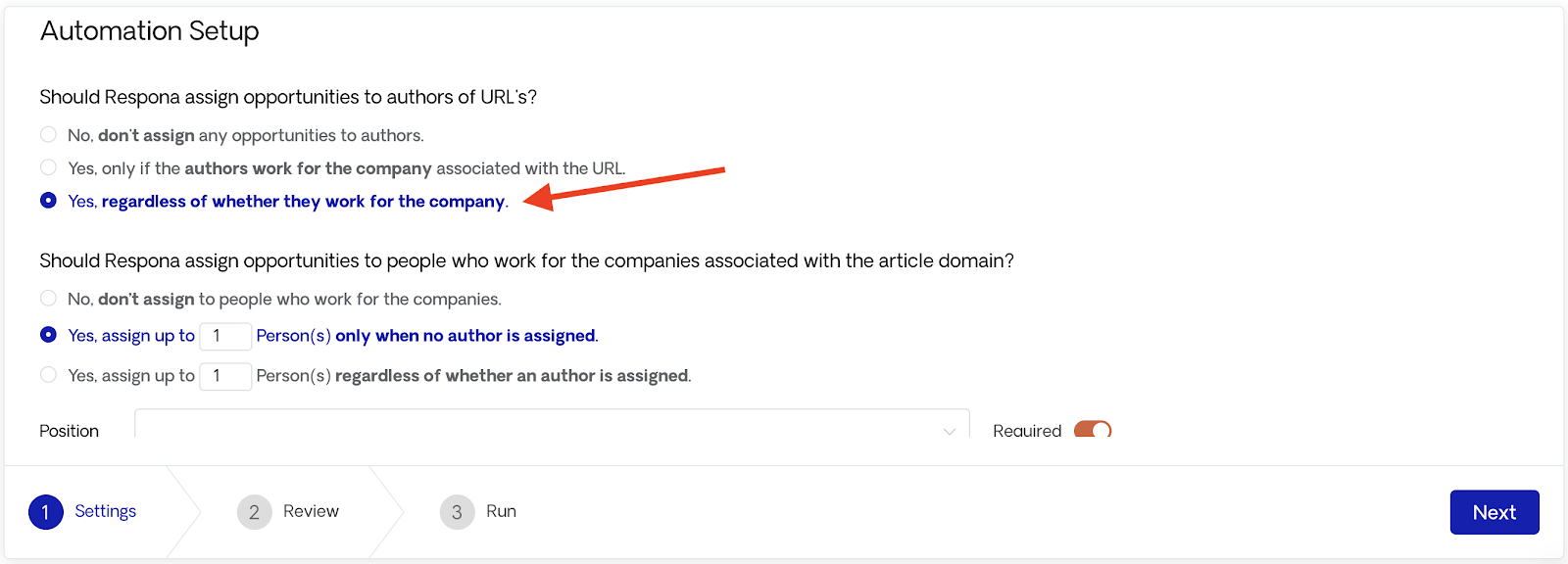

This is a good option if you’re reaching out to blogs, like we do.
As you can see, we’ve chosen the third option and we’ll basically let Respona assign opportunities to people, regardless of whether they work for the company.
Cool, right?
Next, you can also assign opportunities to people who work for the companies associated with the article domain.
This can be very helpful when:
As you can see below, we’ve chosen to assign up to two people from the company we’re reaching out to when no author is assigned.


This is your “safety net” for opportunities where the author doesn’t seem to be the right person to reach out to or when Respona hasn’t found satisfying contact information on the author of the blog post.
On top of that, you can also choose a position and seniority of those people.
As you can see below, we’ve chosen Respona to search for people who work in the company and have the words “editor”, “content”, “marketing”, “SEO” or “writer”.
This means that even if we can’t find the person who wrote the piece (list post with the best CBD oil companies), we can still reach out to someone who has editorial access over the list post we’d like to be featured in.
The screenshot below shows what all parameters look like after making adjustments.


When you’re ready, you can click “Next”.
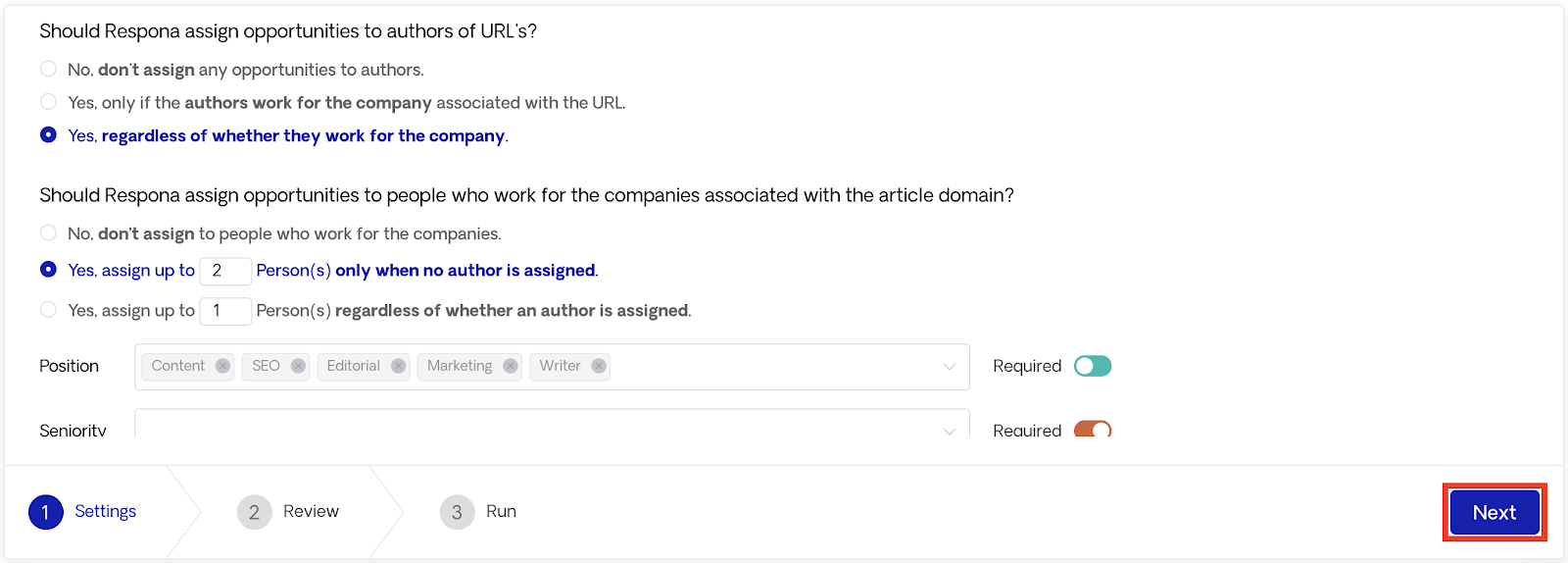

Here’s what you’re going to see next:
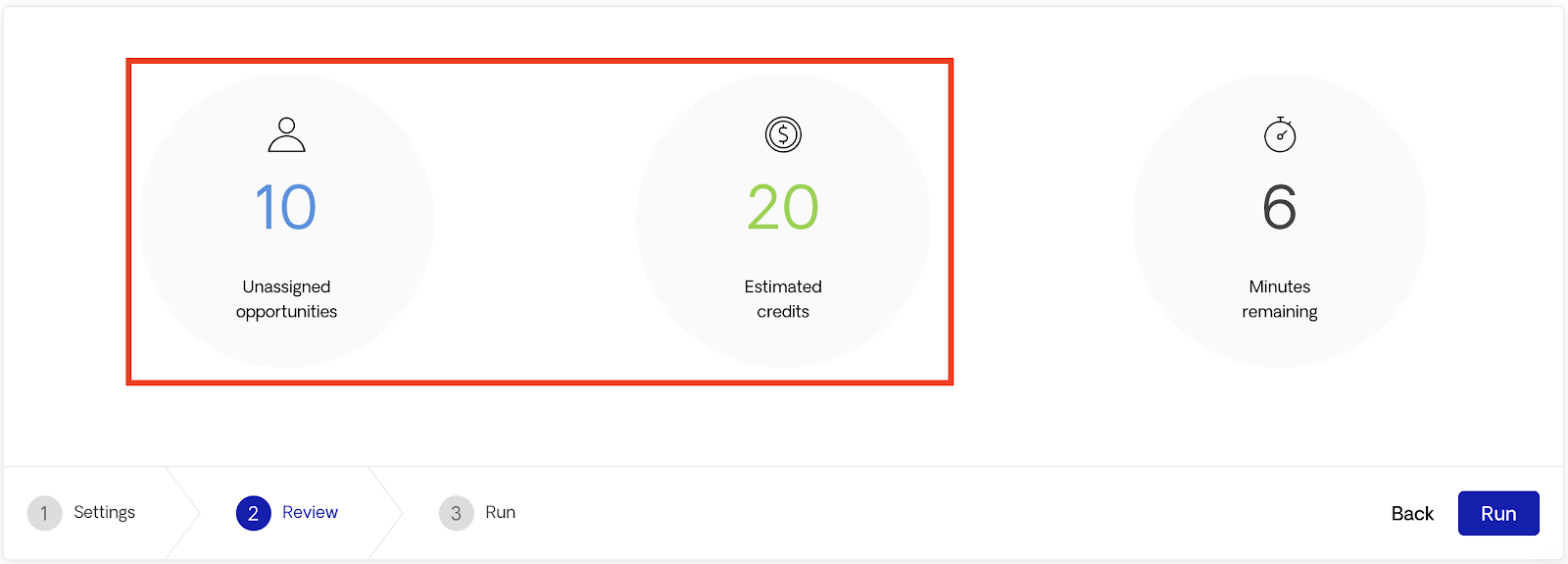

Based on the parameters that we’ve set earlier, Respona will then inform us about:
Note that the number of credits goes up as you choose to reach out to more people within the same company.
This may increase your chances of getting a reply, but it also increases the number of credits this campaign will cost you.
If you’re sure that you want to move forward with all the selected parameters, click on “Run”.
In a few minutes, Respona will return with the exact number of opportunities that were successfully assigned with a contact person/s, the number of opportunities that Respona failed to assign a contact person to, as well as the number of credits this job has cost you.
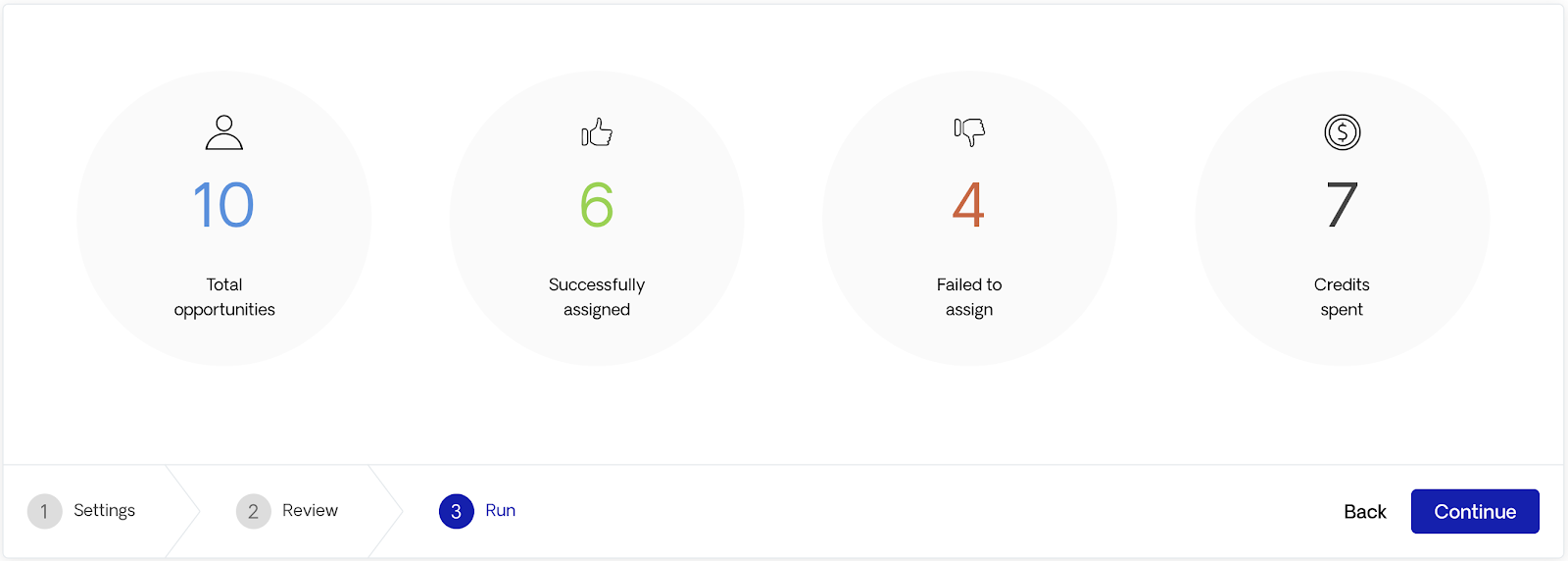

Click “Continue” to move on to the next step.
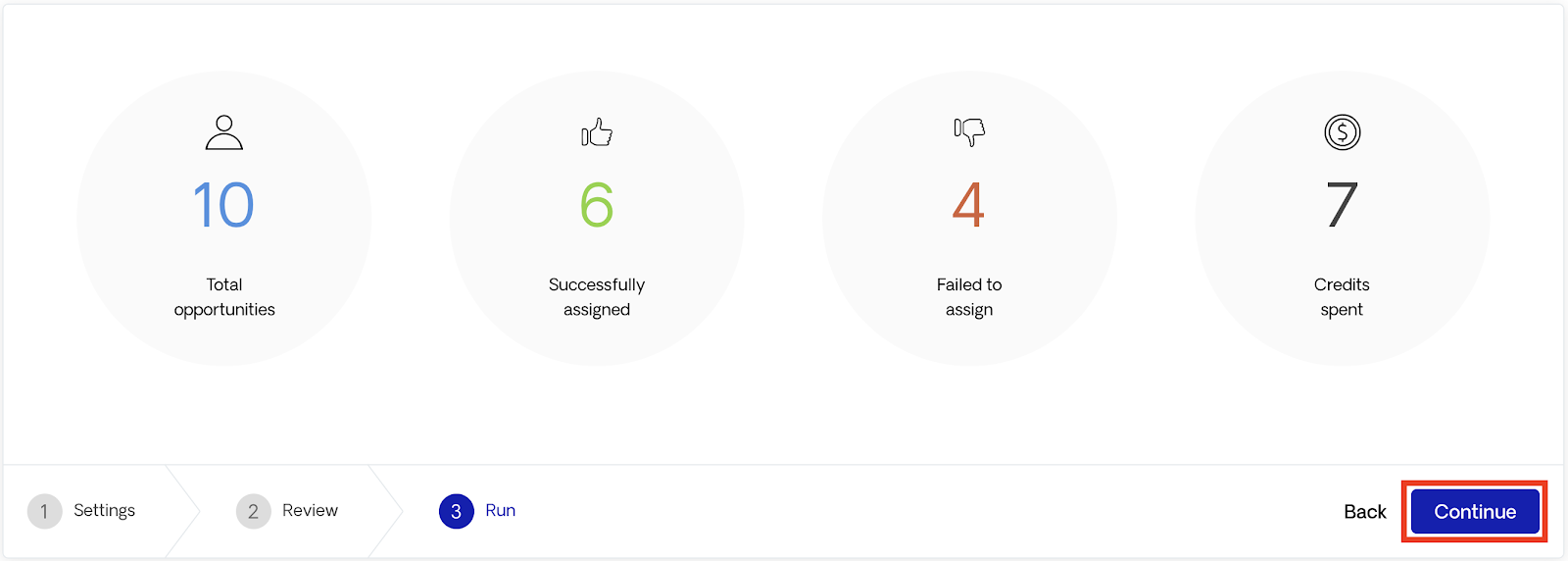

As you can see, six of the opportunities we’ve chosen when we started our campaign have been assigned with a contact person.
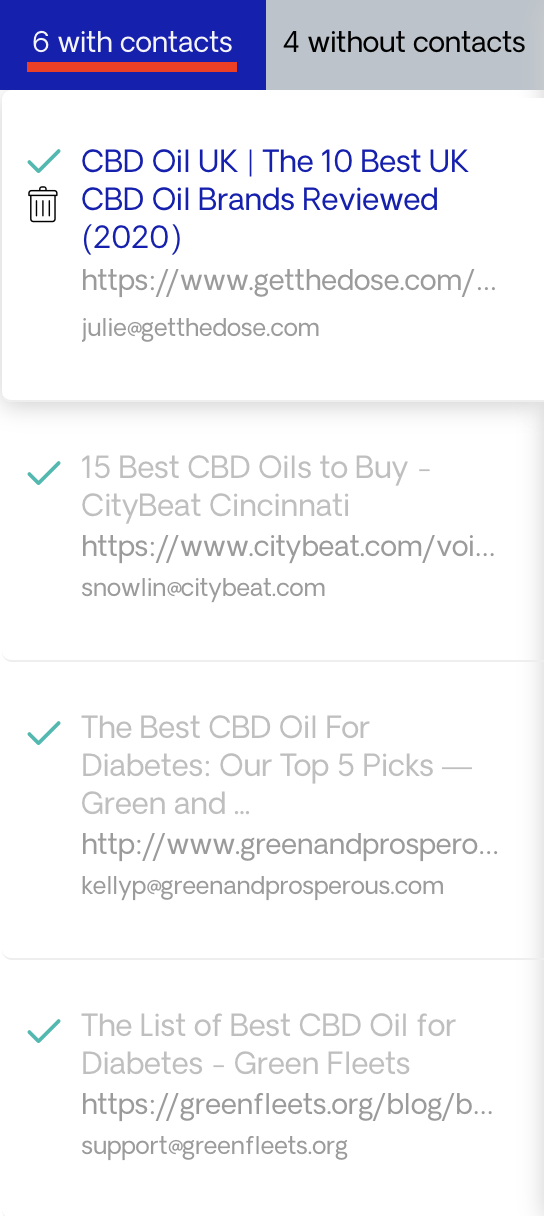

You can make a final review, just to be sure that Respona has indeed identified the right contact people for your campaign.


If everything seems as they should, click on “Next Step” so that you can move to the last step of the process.


What do you need to do next?
Personalize your campaign and hit the launch button!
By now, you’ve found the opportunities you want to reach out to, you’ve prepared your email pitches, and you’ve successfully found the contact details of the people you’re about to reach out to.
What’s left?
Personalizing your email and launching your CBD marketing campaign.
As you can see below – where the numbers are – Respona has already moved all important information to the email, based on the information extracted from each opportunity.
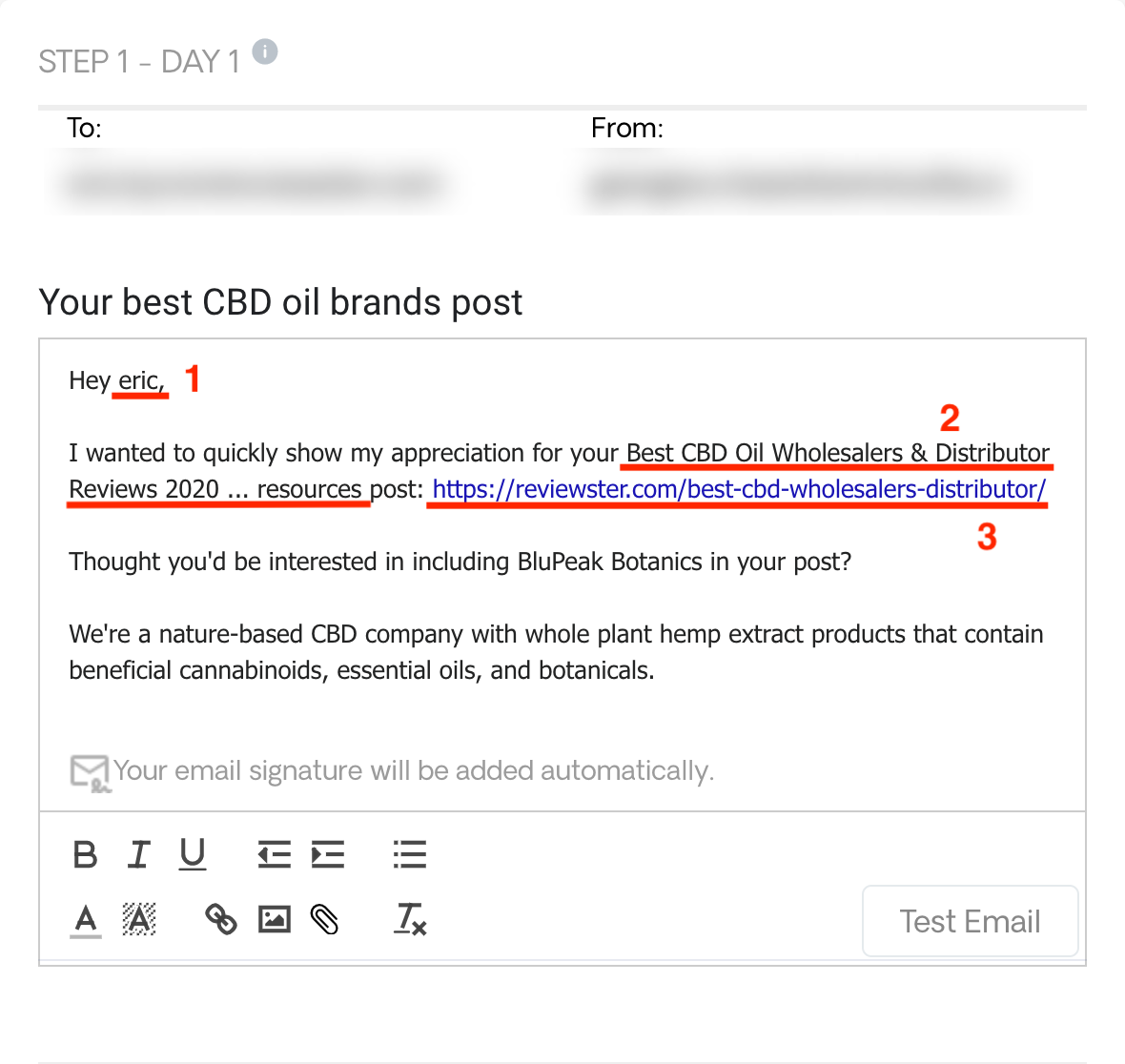

Even though you may argue that this is enough, we can do something more to personalize each of the emails we’re about to send.
How?
By choosing one of the suggested excerpts – text on the right of the screen – by Respona.
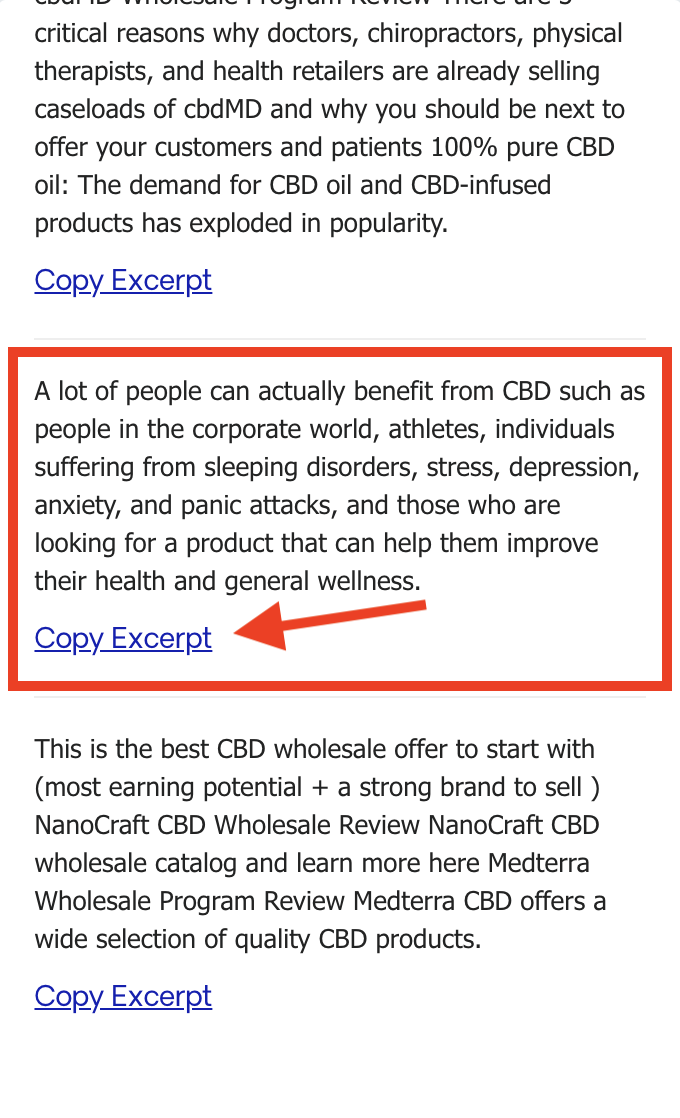

These are pieces of text extracted from the pieces of content, in our case, list posts, in our list of opportunities, that will help us show to our prospects that we’ve actually read their piece of content.
You can copy any excerpt you like by clicking on “Copy excerpt” and pasting it into the email.
Of course, you can adjust it further and even add your opinion to show that you’re a true expert when it comes to CBD and cannabis products.
What’s next?
Making a final review and launching your CBD marketing campaign.


The strategy that we’ve outlined is just one of the many you can use to build links and authority for your CBD business.
There are many others, like pitching yourself as a podcast guest or pitching your CBD products to news and media outlets, all of which you can implement right from Respona.
There’s one more thing you can do with Respona.
Let’s take a look at it before we wrap this up.
Have you ever heard of HARO?
It’s a place where you can pitch journalists and get media coverage for your business.
As the interest for CBD products and cannabis is increasing, we expect the content that gets published out there to be increasing as well.
A huge part of that content production will come from journalists.
Those journalists are looking for people like you — people who’re experts in specific topics — to use as sources.
You can find those opportunities and pitch your knowledge and brand through Respona.
How?
First, click on “Opportunities”.
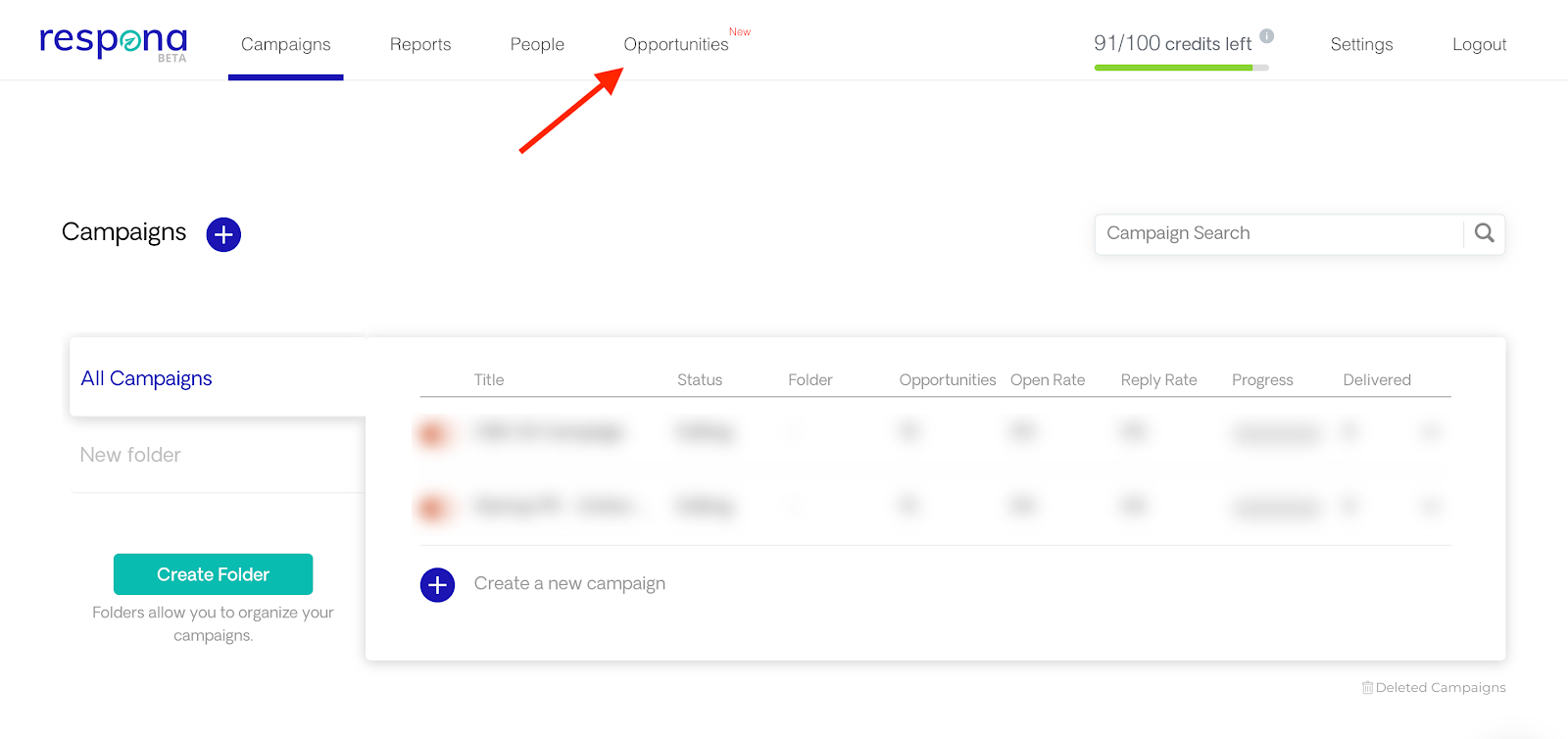

Then, choose “HARO”.
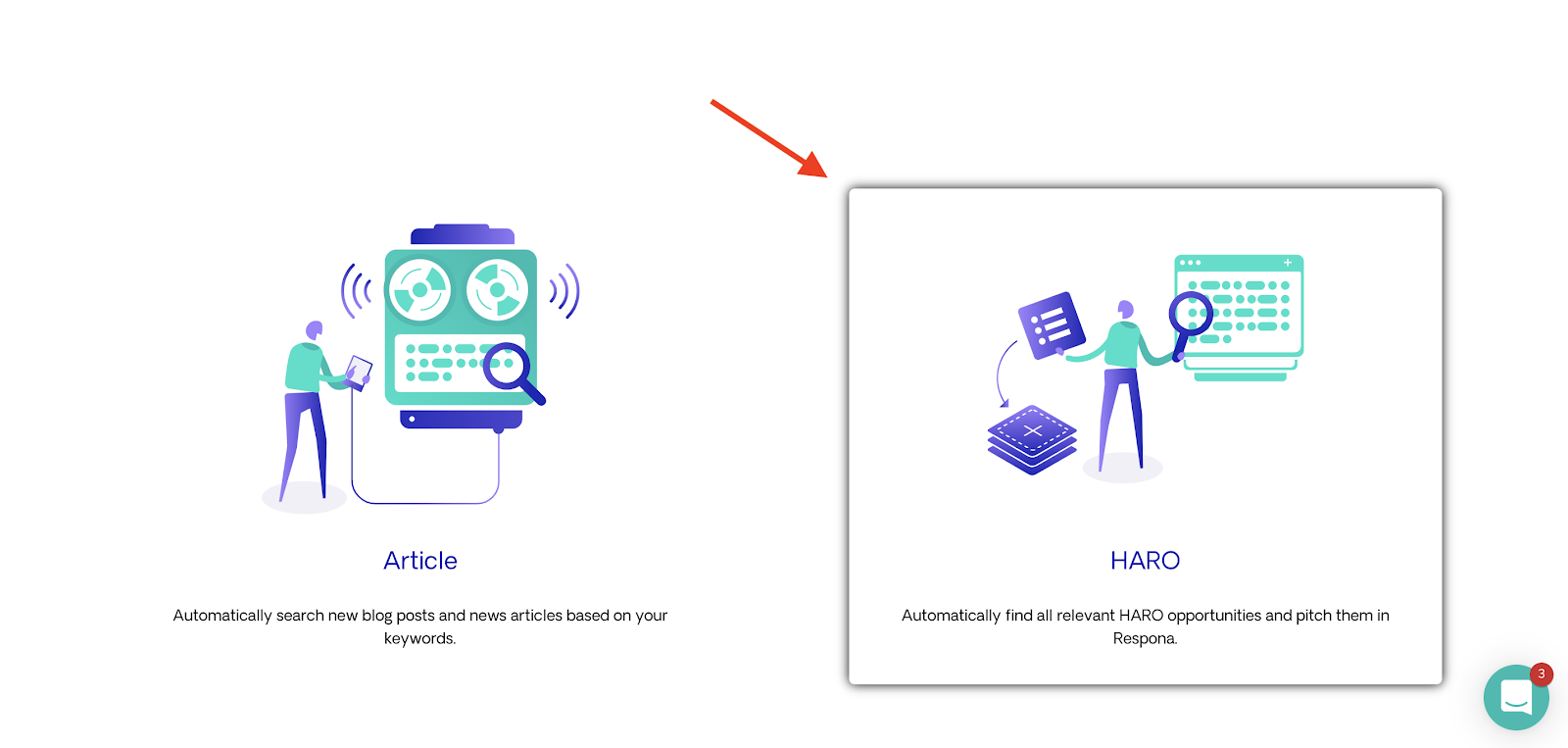

Next, you need to set up your HARO automation campaign, as shown below.
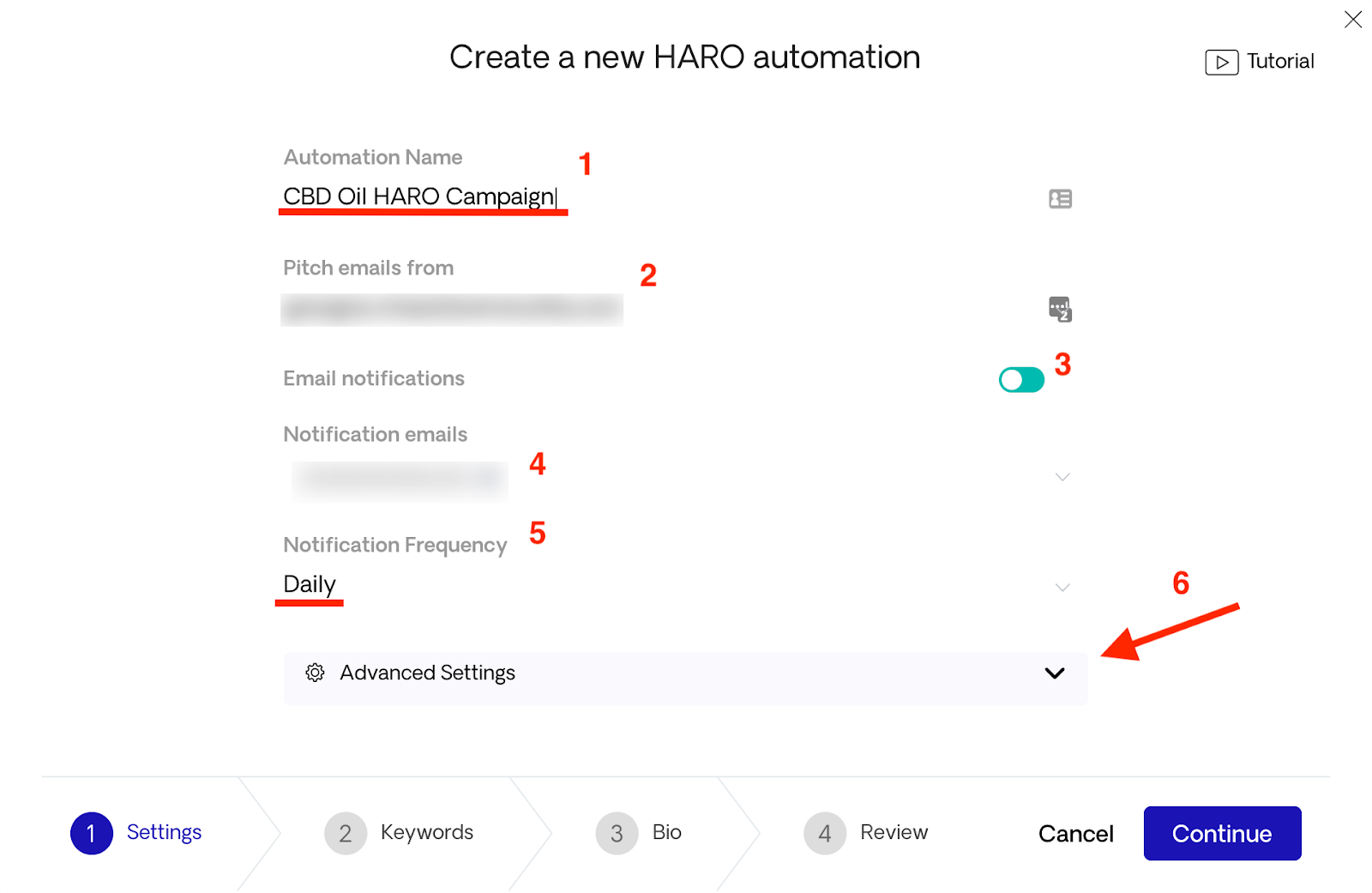

Here are the different settings you need to adjust:


Done adjusting your automation settings?
Click “Continue” and you’re good to go.
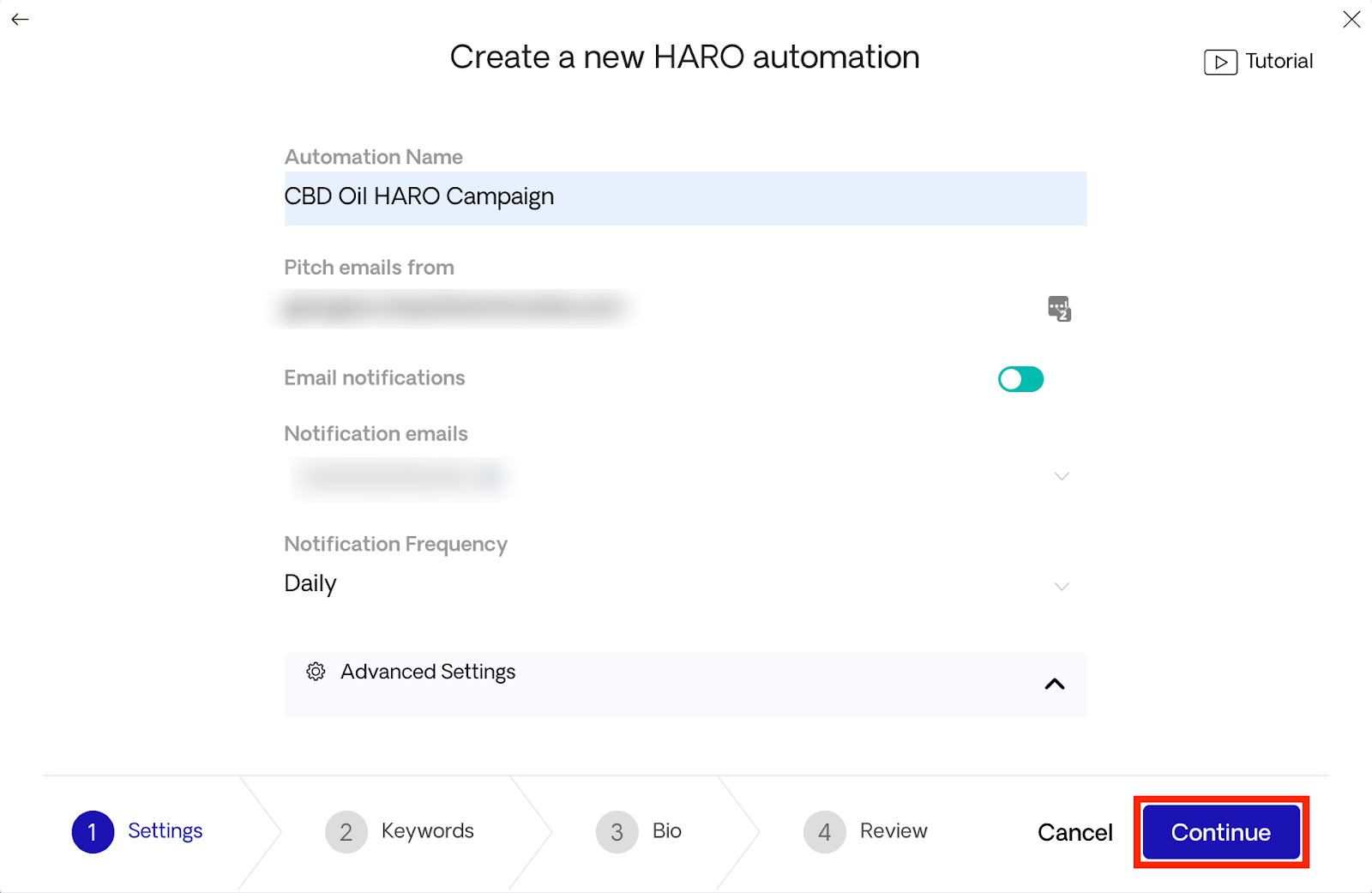

Here’s what you’ll see next.
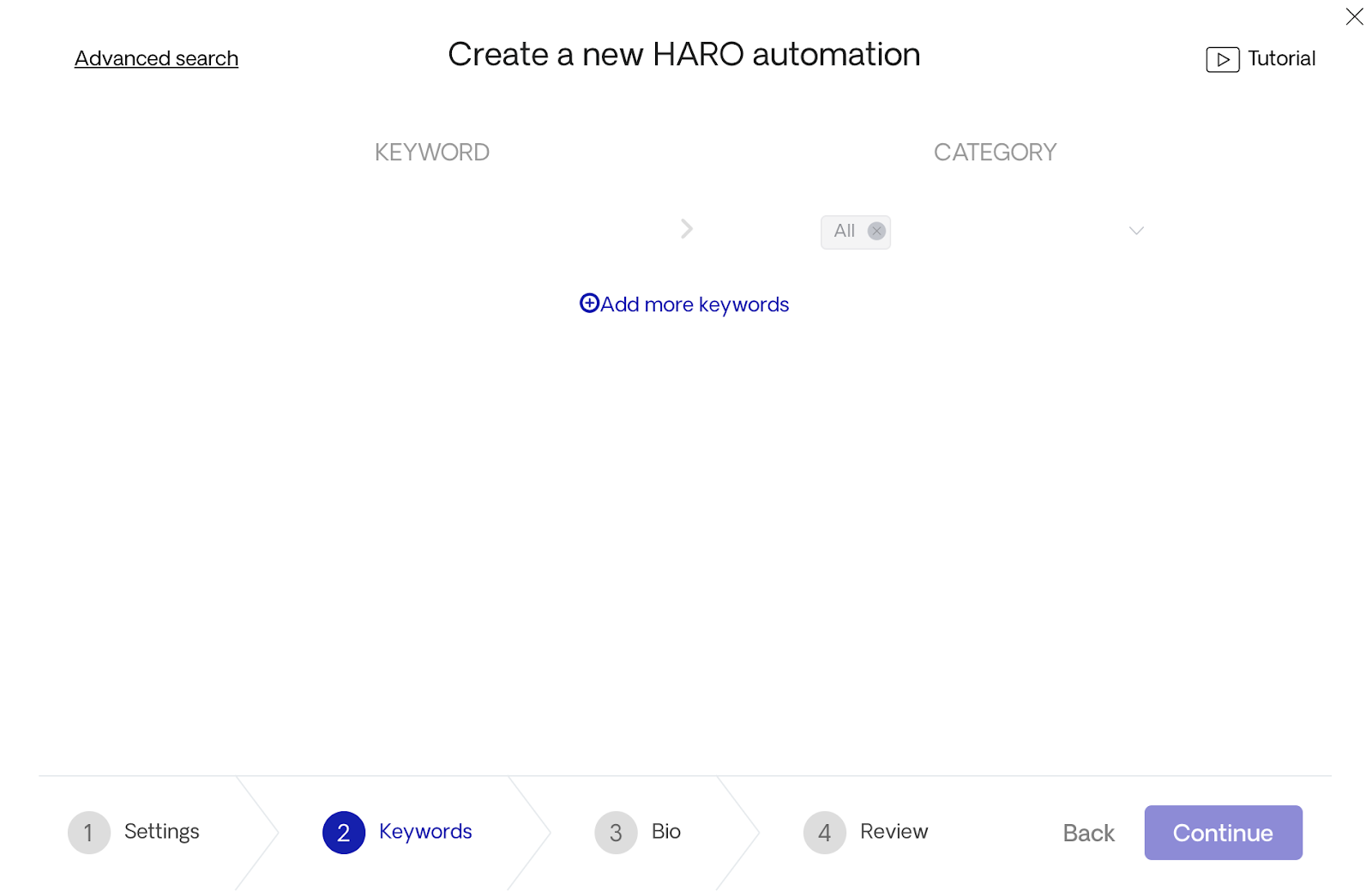

Here, you have to add the keywords you want Respona to be looking for to find relevant opportunities.
For example, one of the keywords we could choose for our CBD oil business is “cbd oil”.


At the same time, you can choose the “Category” you want the opportunities to belong to.
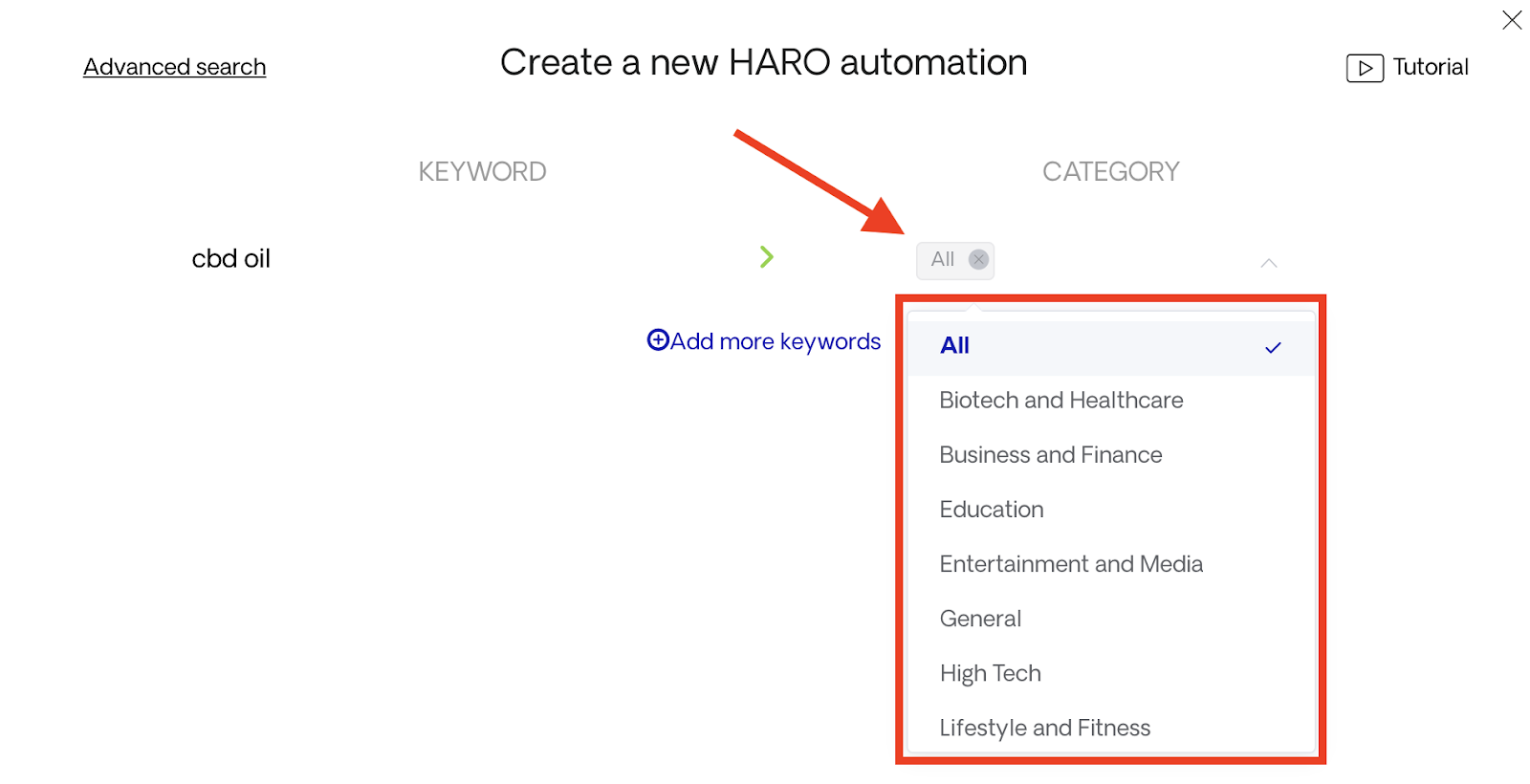

We recommend leaving that to “All” as it is by default.
You can, and have to add more keywords so that your automation is ready.
Here are the keywords we came up with for the purposes of this campaign.
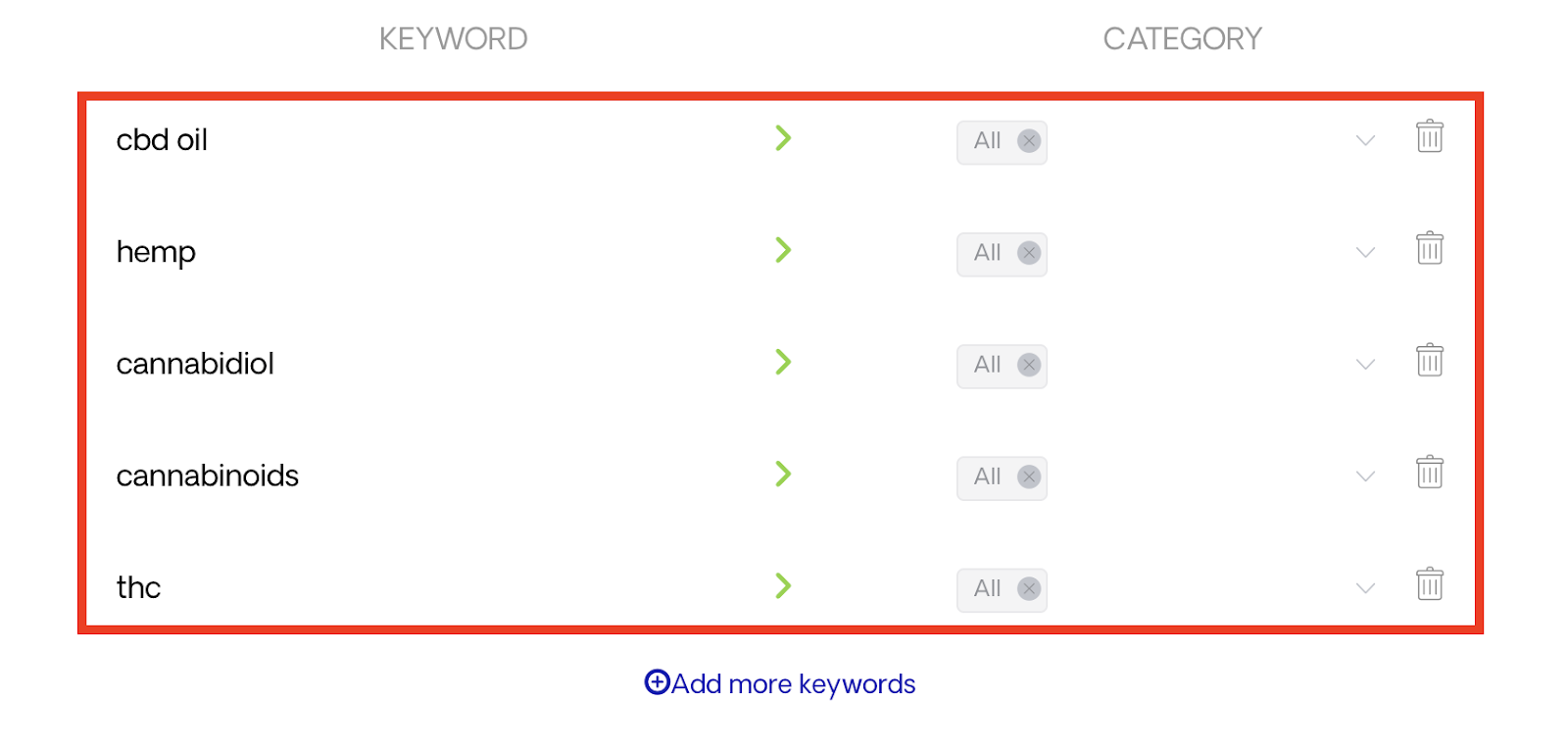

When you’re ready, you can click on “Continue”.
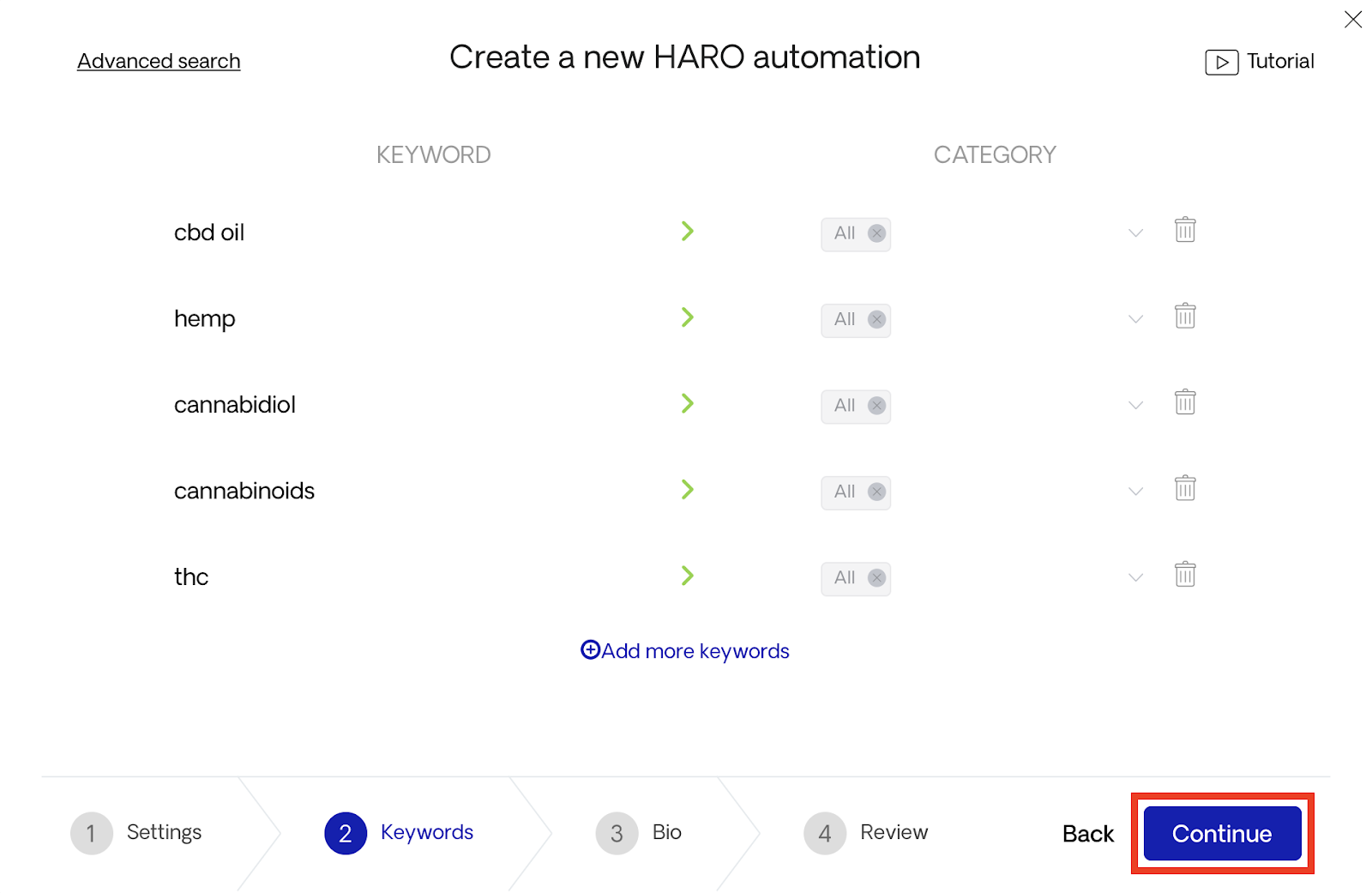

Next, you need to add your contact information, in case any of the opportunities you’ve pitched may want to get in touch or use you as a source.
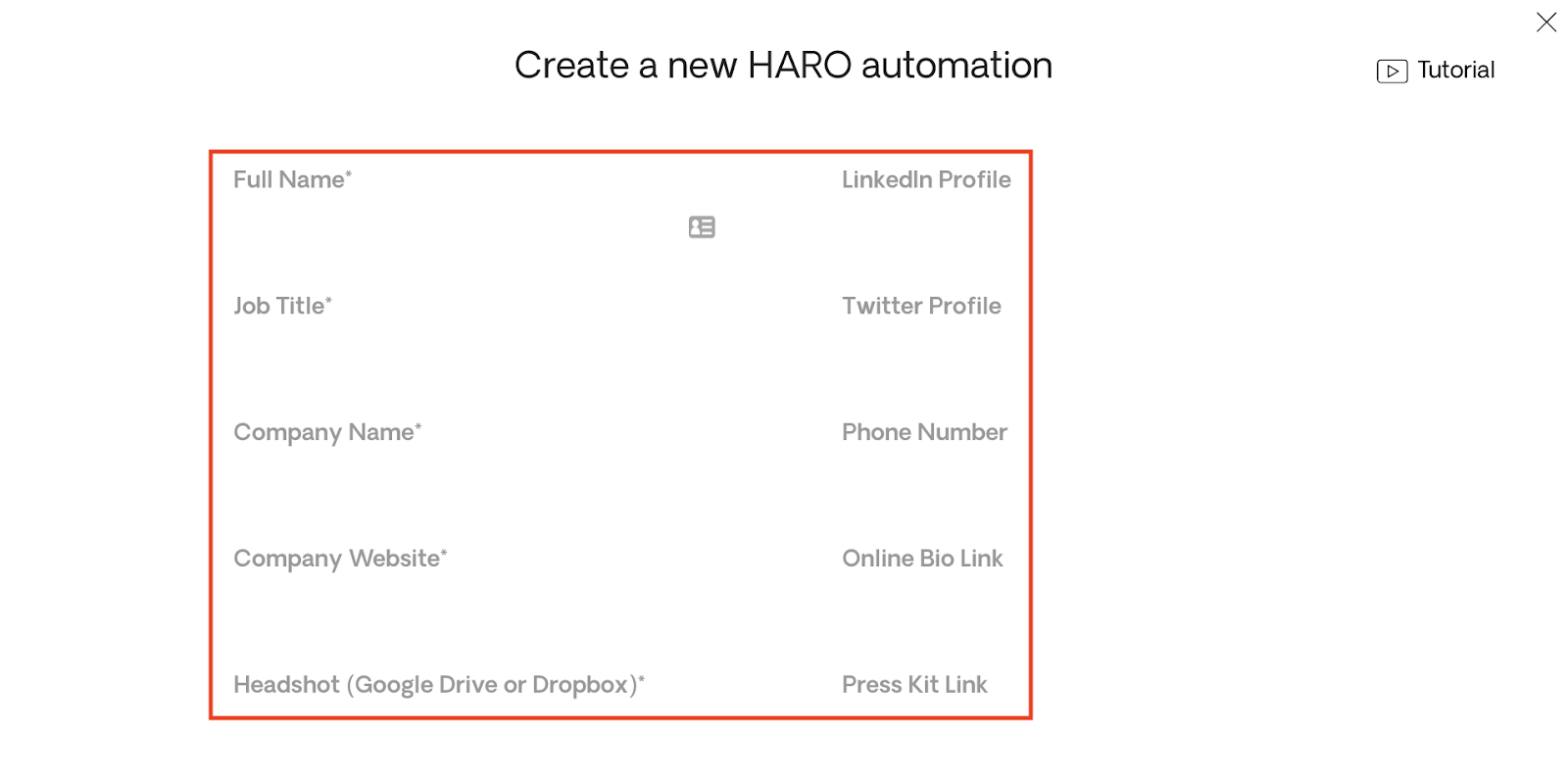

Here’s how the information would look if I were to pitch an opportunity:
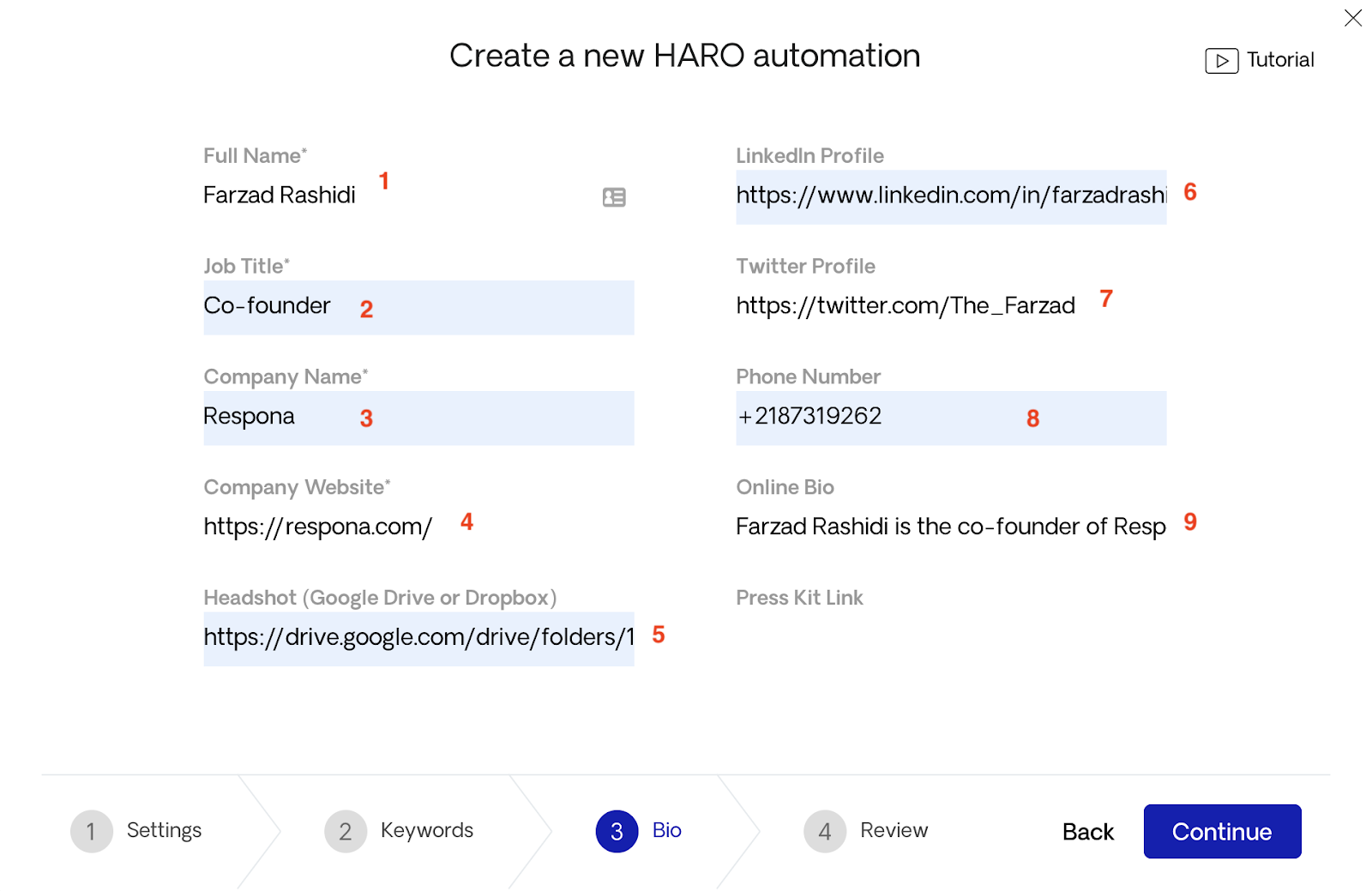

When you’re done, you can click on “Continue” once more.
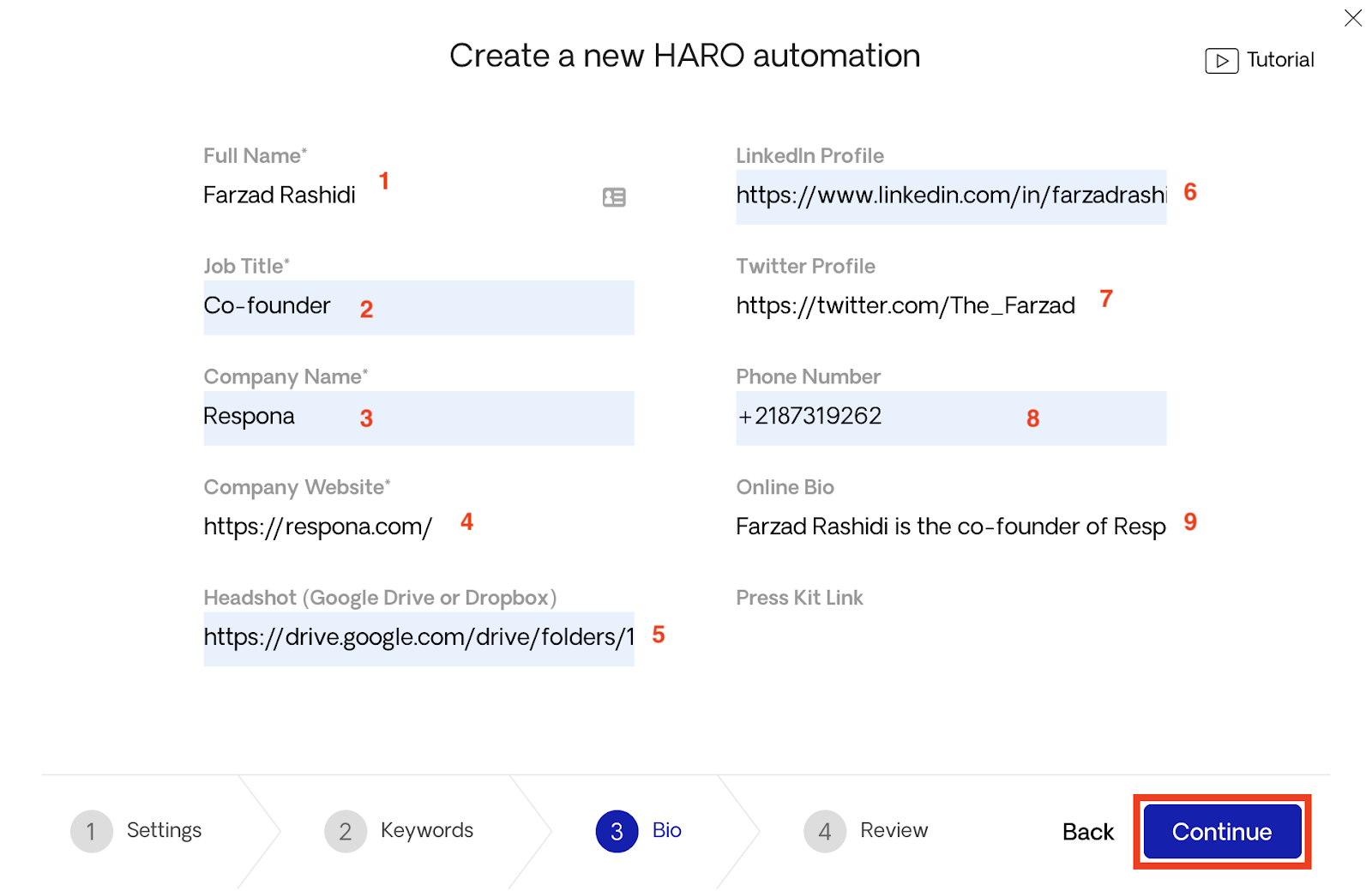

After making a final review and making sure that everything is as it should be, you can click on “Create”.
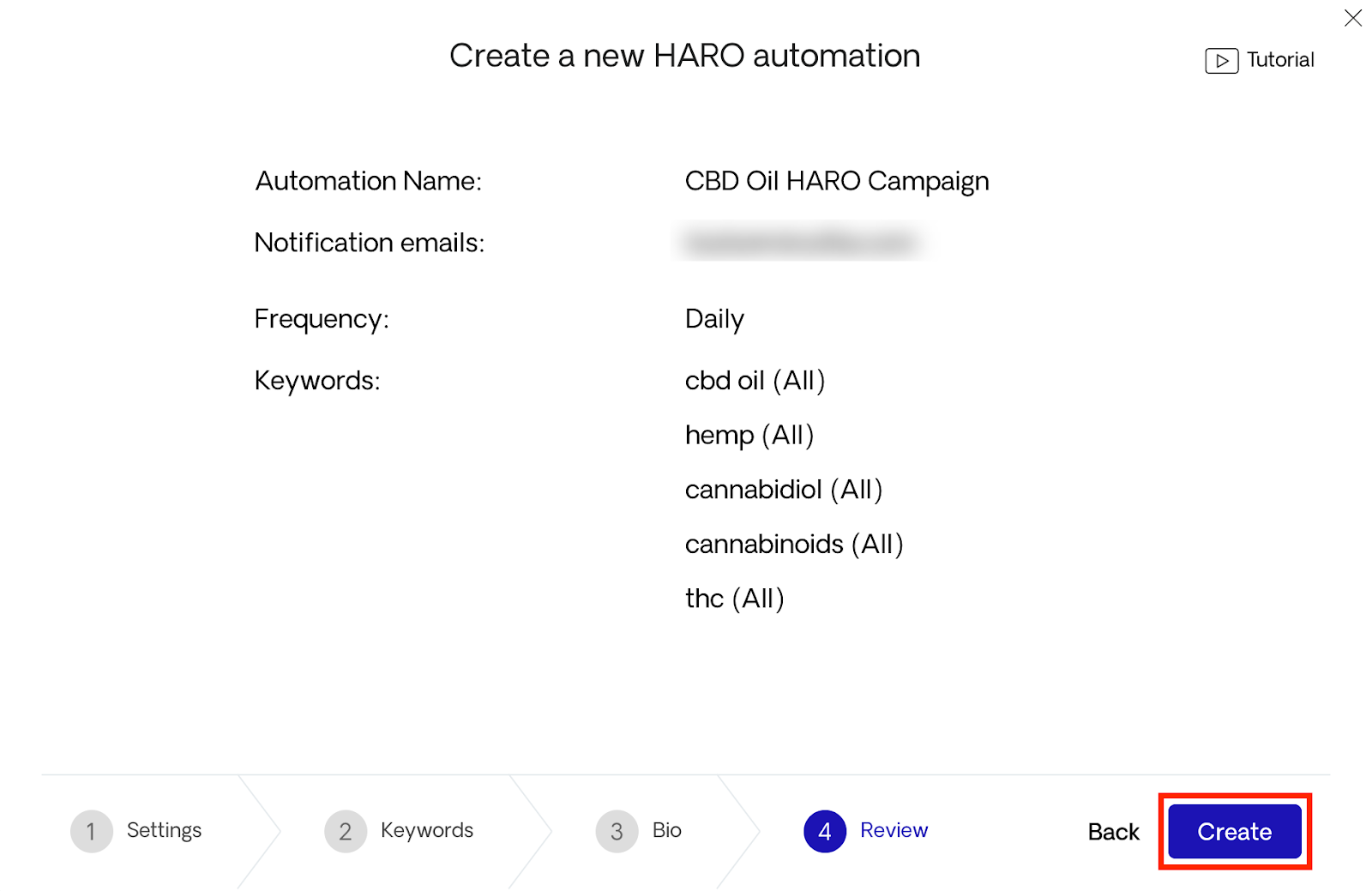

From there, you’ll be receiving opportunities in your inbox or right in Respona whenever one of your selected keywords are found in the HARO opportunities that come up.
Here’s how relevant HARO opportunities look like:


You can choose to see more details about any of the opportunities that interest you, by clicking at the “View Details” button which is placed right below the opportunity title.
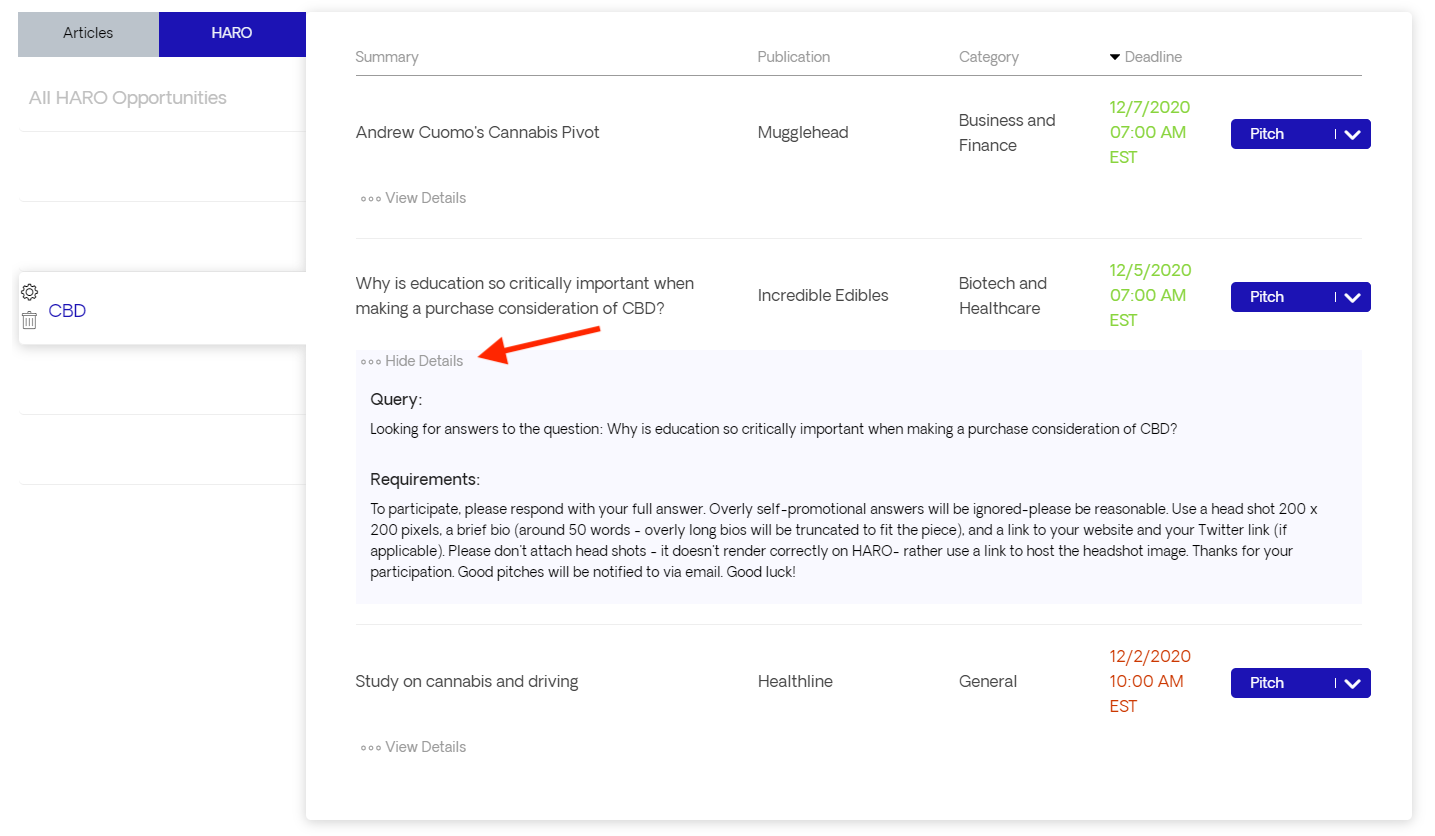

There, you can actually see whether this is a relevant opportunity you’re experienced with.
If you feel that this is indeed something you feel comfortable with answering, you can click on “Pitch”.
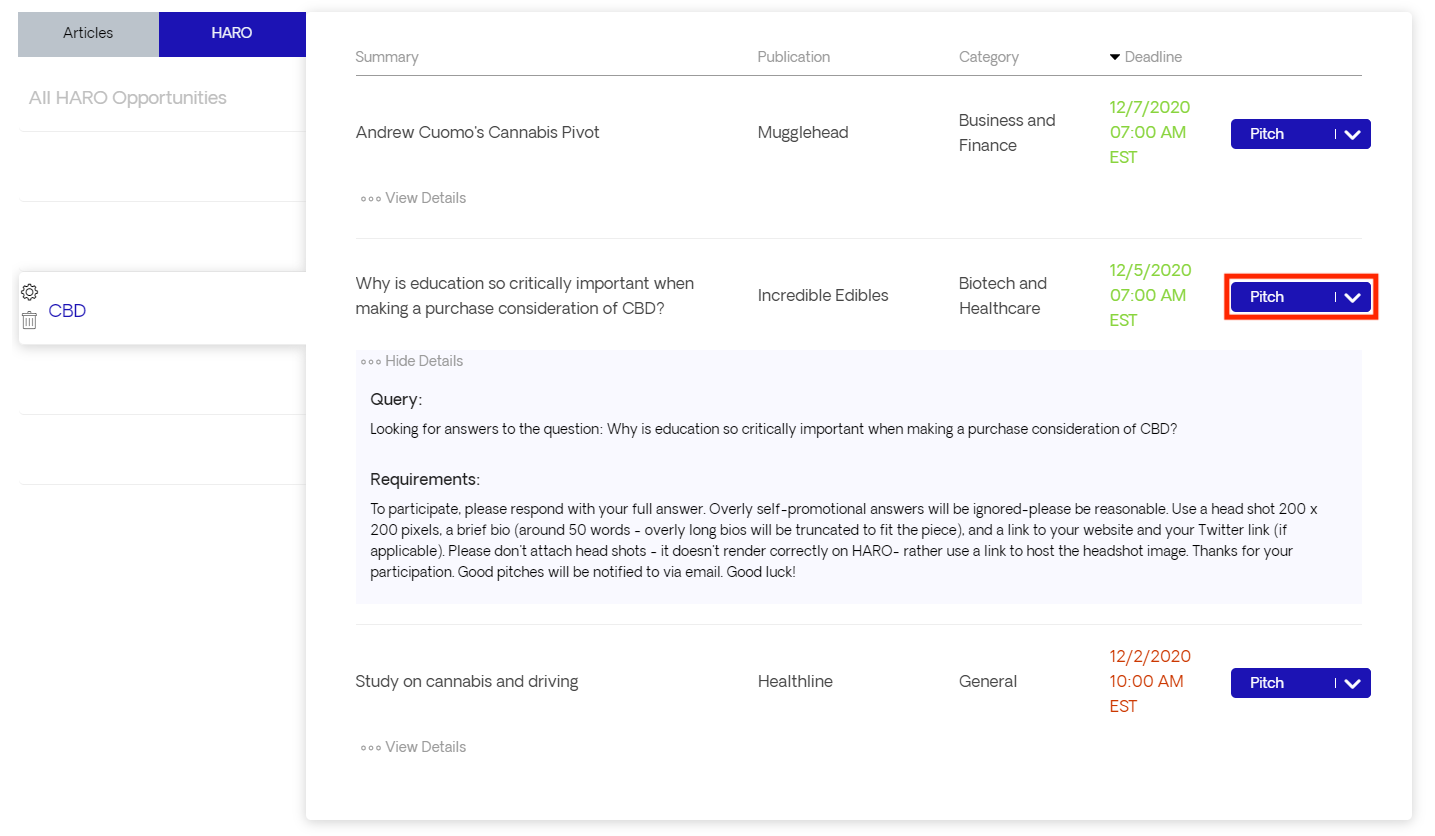

From there, you can create your email pitch and send it right away.
The details of the opportunity are displayed in the right side of the window, as you can see below.
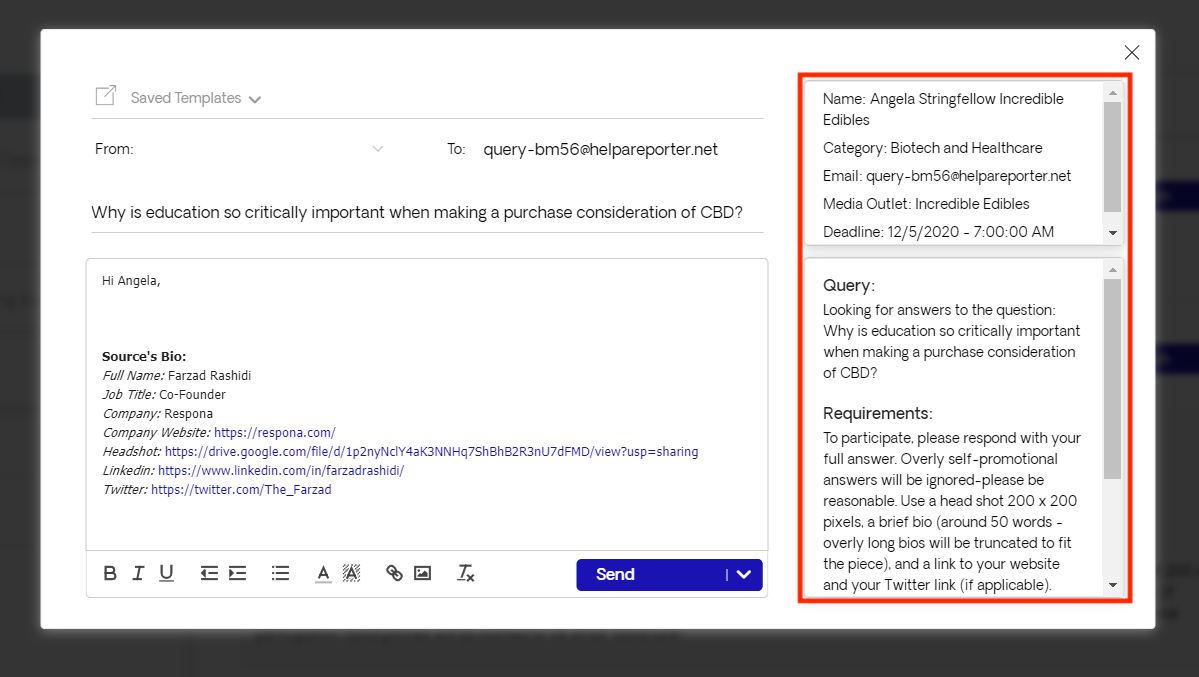

When you’re ready, you can click on the “Send” button.
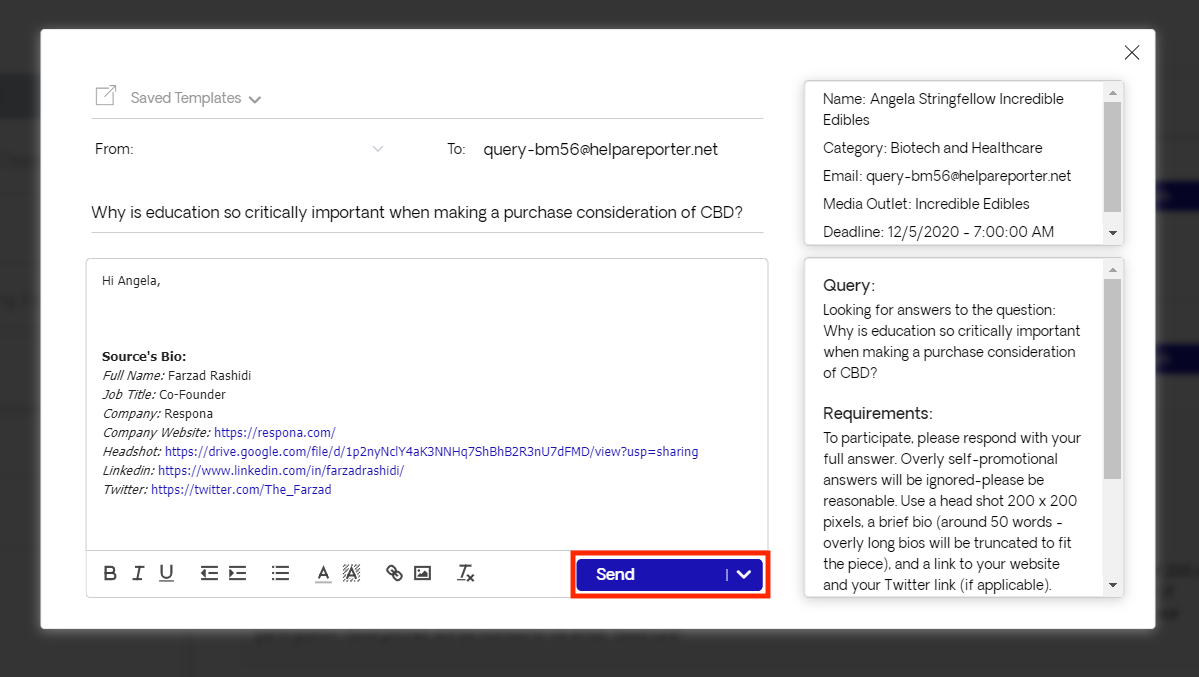

If the journalist you’re pitching is interested in your pitch, she will get back to you or let you know that your quote went live.
Now, you have two ways you can use to promote your CBD business.
Let’s wrap this up and close with some final thoughts.
The cannabis industry and CBD brands have been hit really hard in terms of advertising and promoting their products.
There may still be many restrictions around CBD advertising and marketing but as a marketer, you have to find creative ways to promote your products.
In this guide, we saw some of the most prominent ways to include in your marketing strategy.
We’ve also broken down the differences between doing marketing by yourself and hiring a CBD marketing agency.
It is clear that developing and applying a CBD marketing strategy by yourself has many benefits that can’t be overseen.
The best — and probably most important one — is the fact that by applying these digital marketing strategies yourself, you’ll get to know the CBD market better.
If you’re ready to kick-off your first outreach campaign and start promoting your website, Respona is the best way to go.
Just request a demo and see what our tool can do for you!
Here’s some answers to some of the most common questions when it comes to CBD marketing.
According to Facebook’s official policy on the matter, companies cannot sell CBD oil products on the platform.
CBD products are banned from eBay although some sellers might try to use them by avoiding the use of the term CBD in their product listing.
CBD brands can post content that features CBD products on Instagram.
However, there might be restrictions when using the term CBD.
It’s not possible to sell CBD on Facebook Marketplace.
The company applies restrictions on selling CBD products.
You can definitely advertise CBD online.
Traditional social media ads and Google ads might be tricky, but you can always consider using marketing alternatives, such as affiliate marketing, influencer marketing, etc.
Although there are claims of people that say that they’ve seen CBD products advertised on Google Ads, the company’s official advertising policy lists CBD under prohibited products.
Square has launched a CBD early-access program which allows brands across the USA to sell CBD on the platform.
Using PayPal to sell CBD products would not be a good idea.
There’s a great chance that your account might get frozen or suspended.
No spam, no BS, unsubscribe at any time.